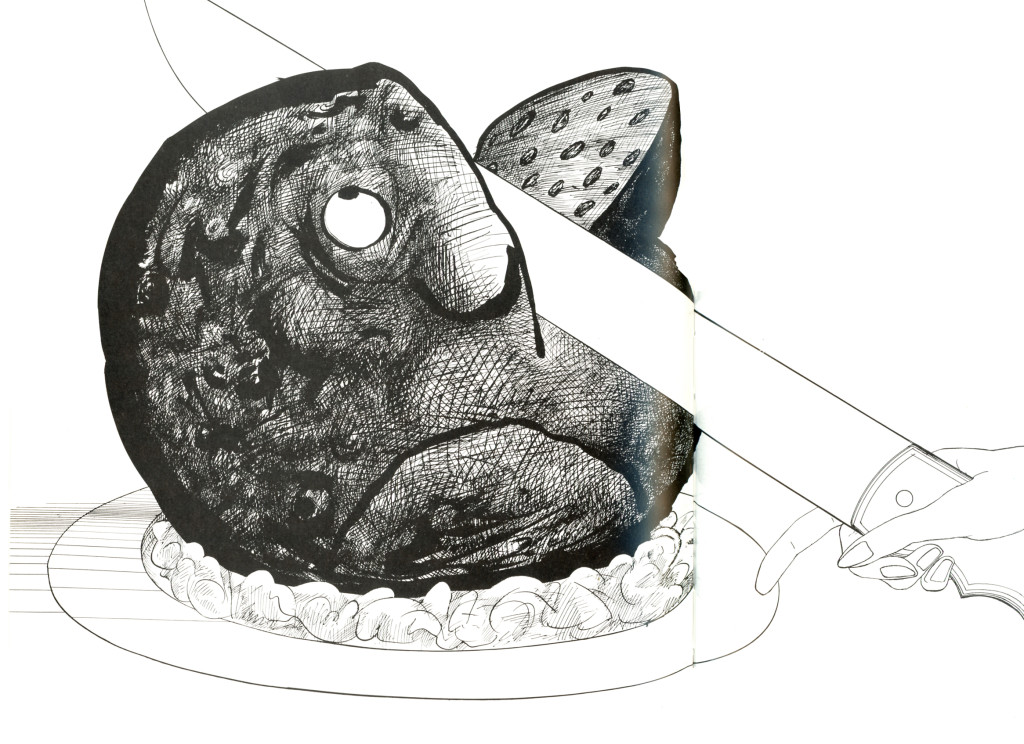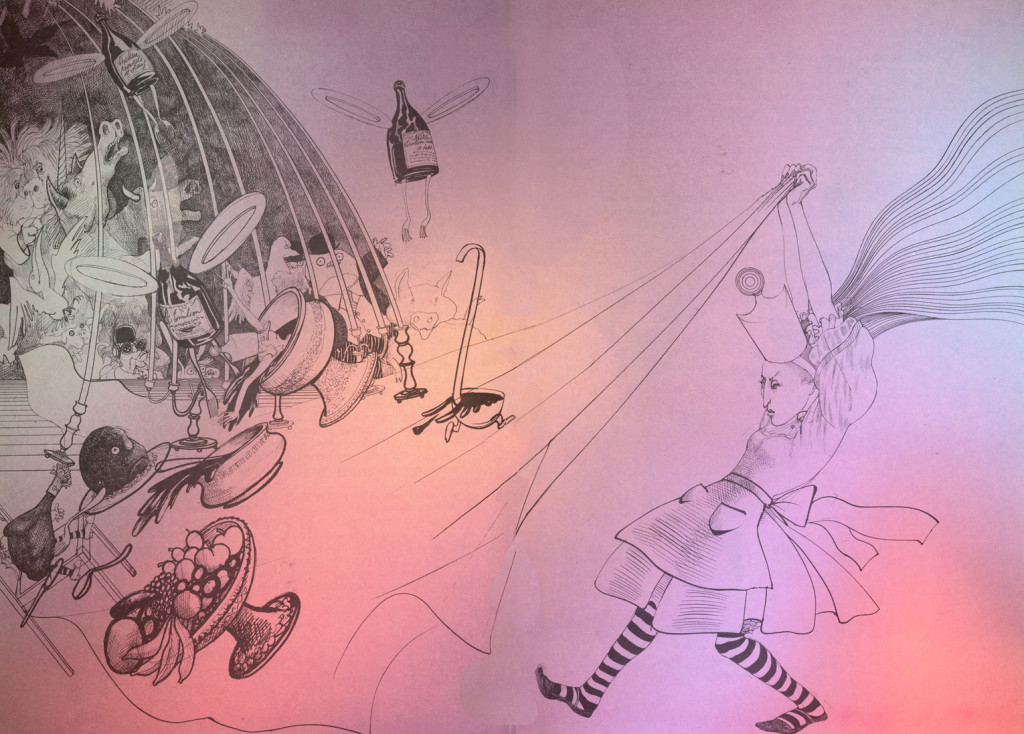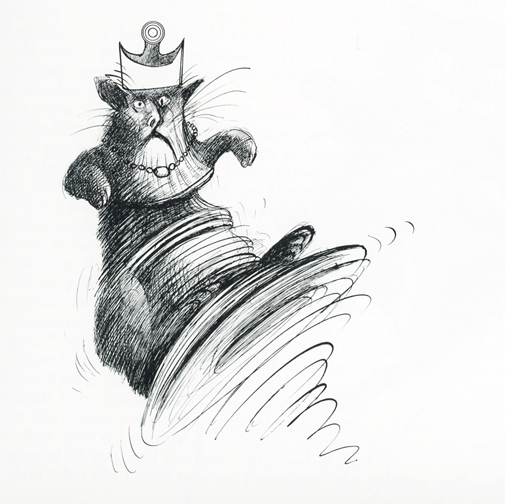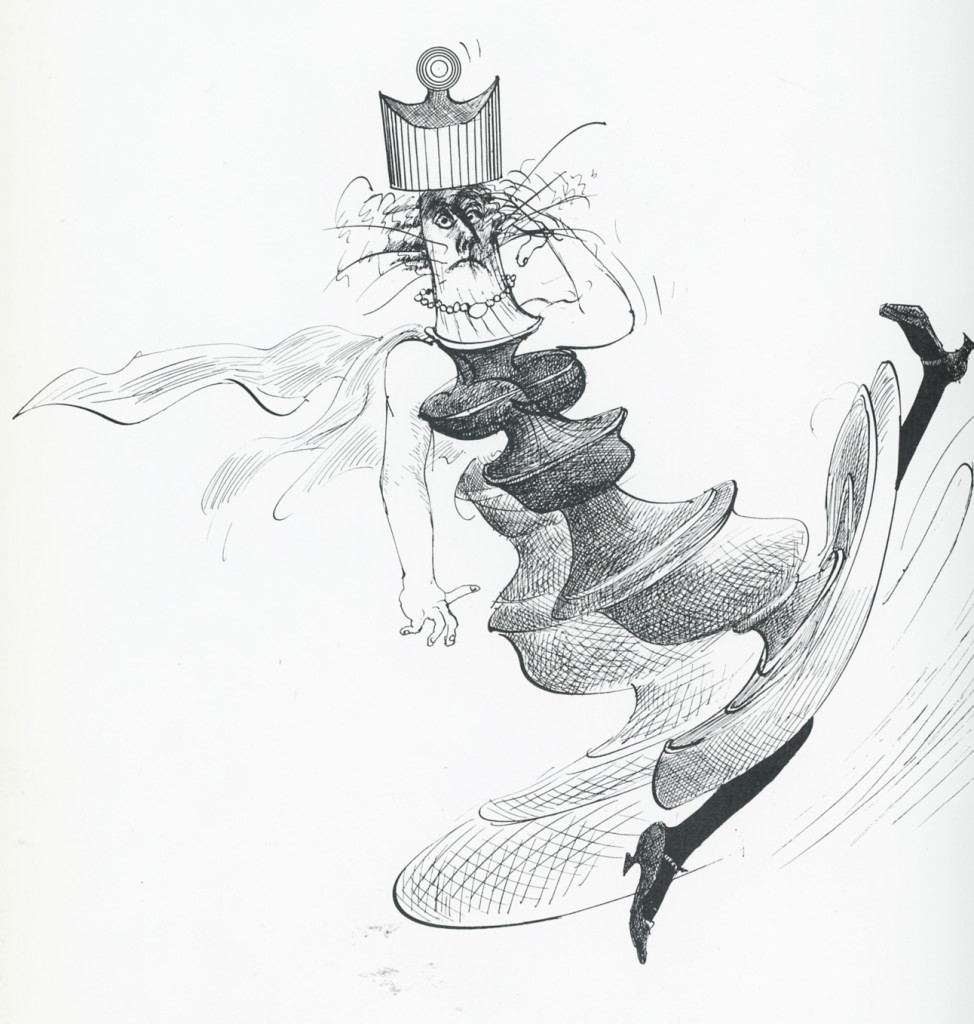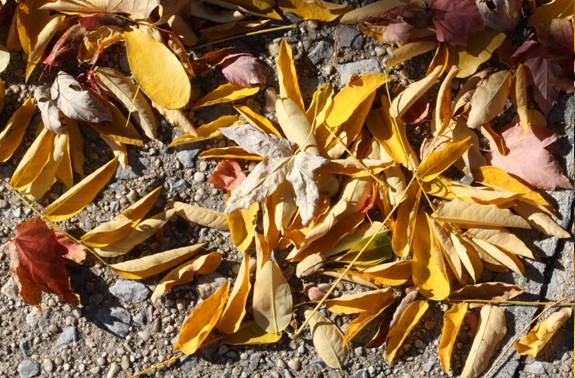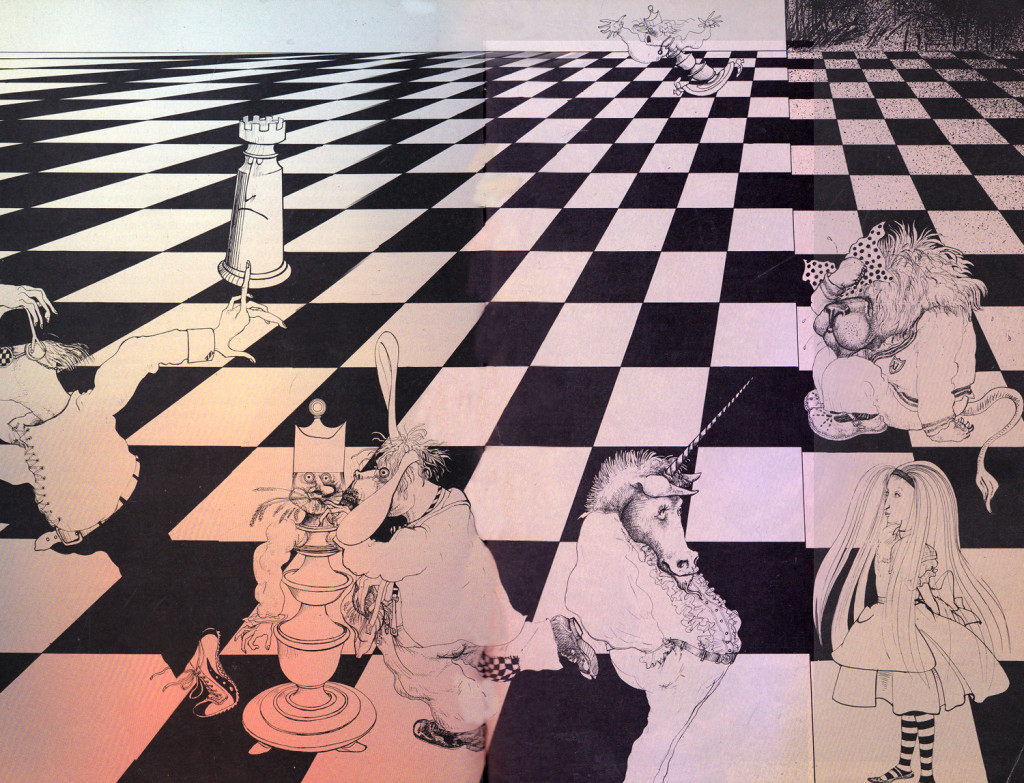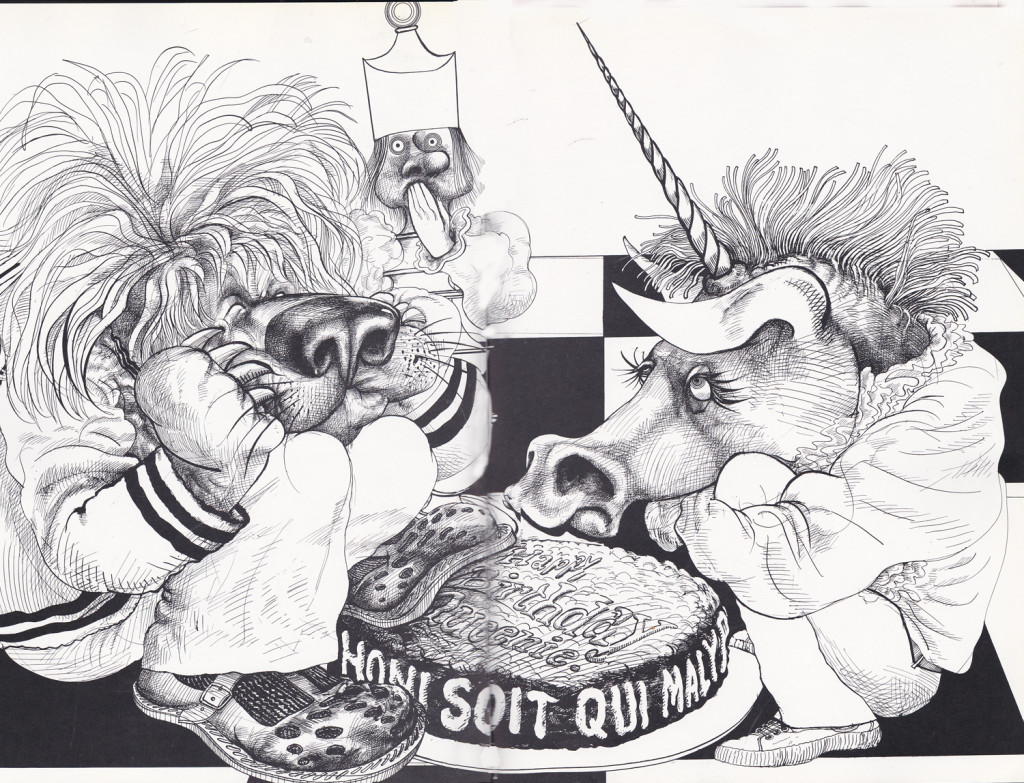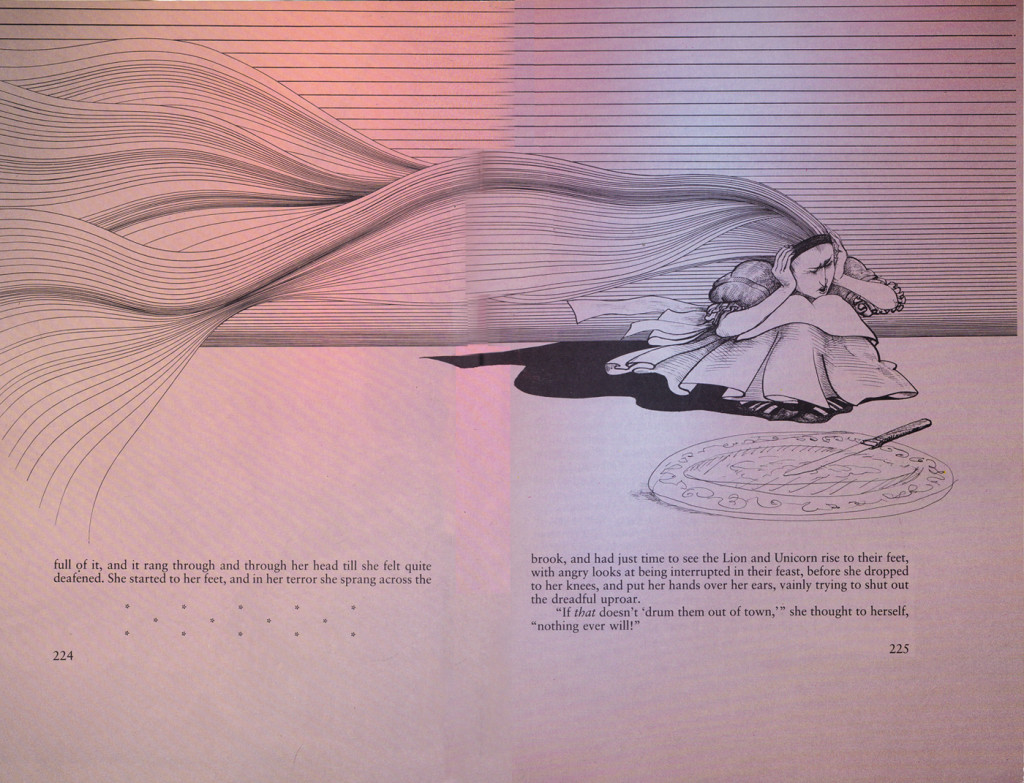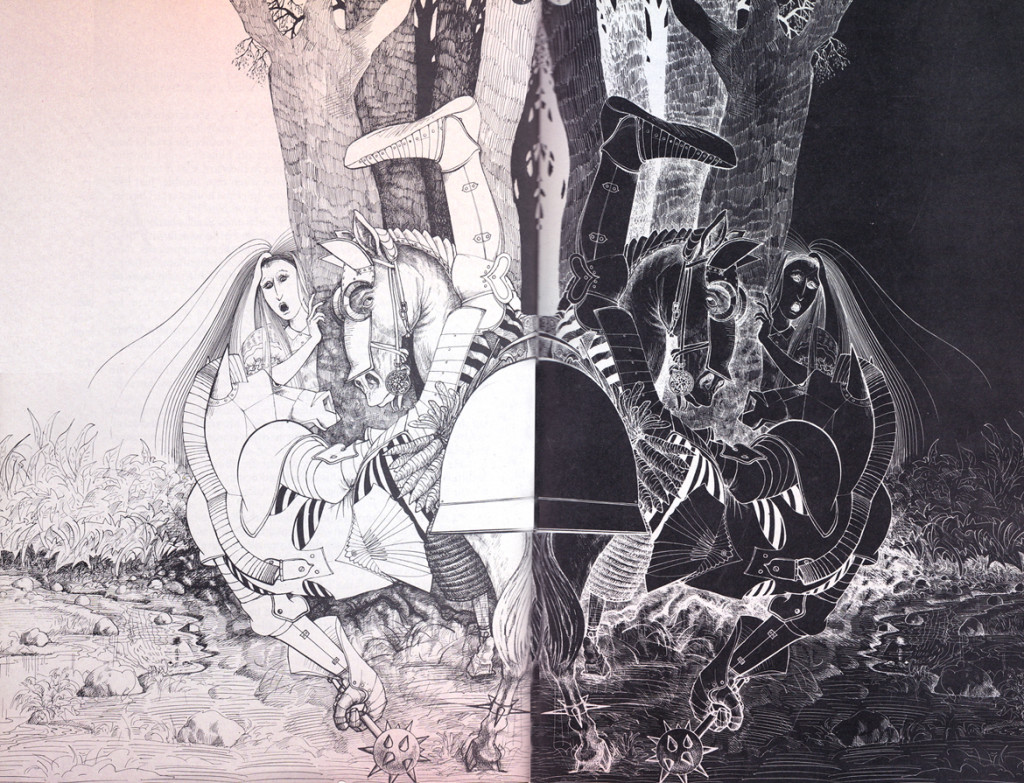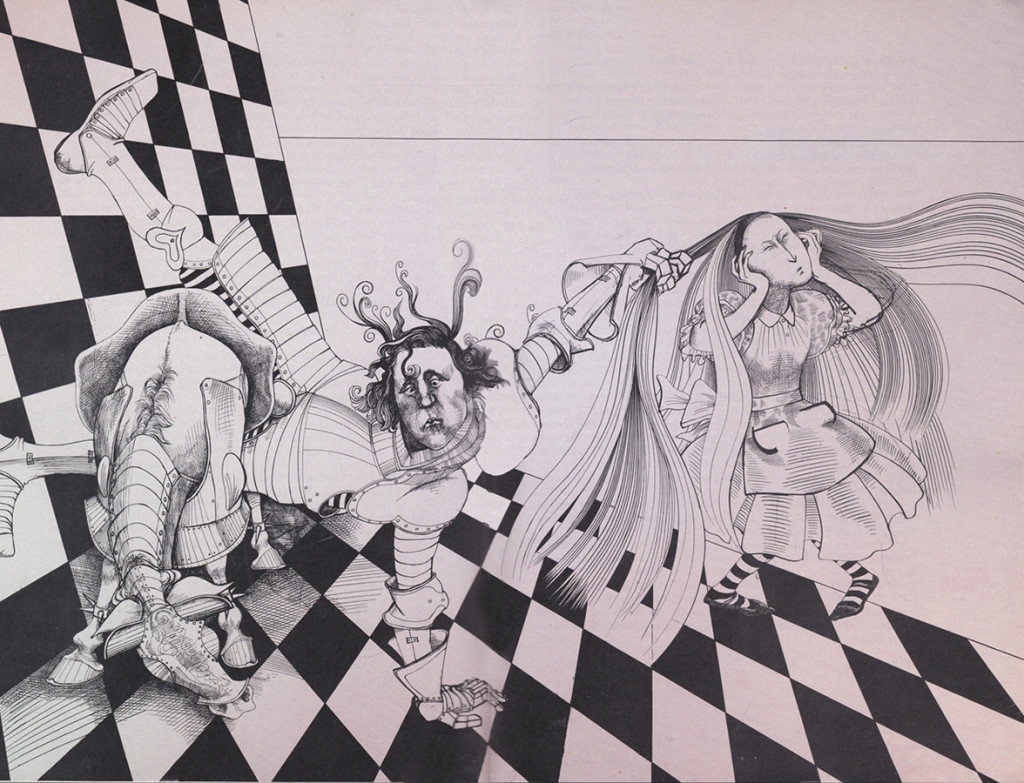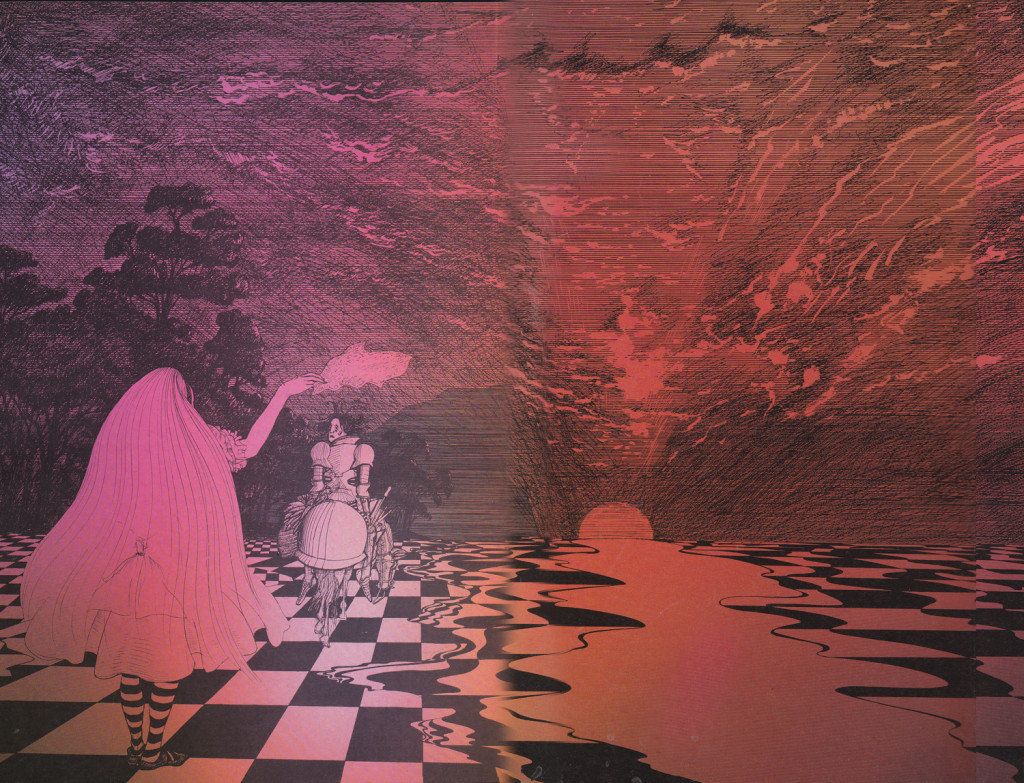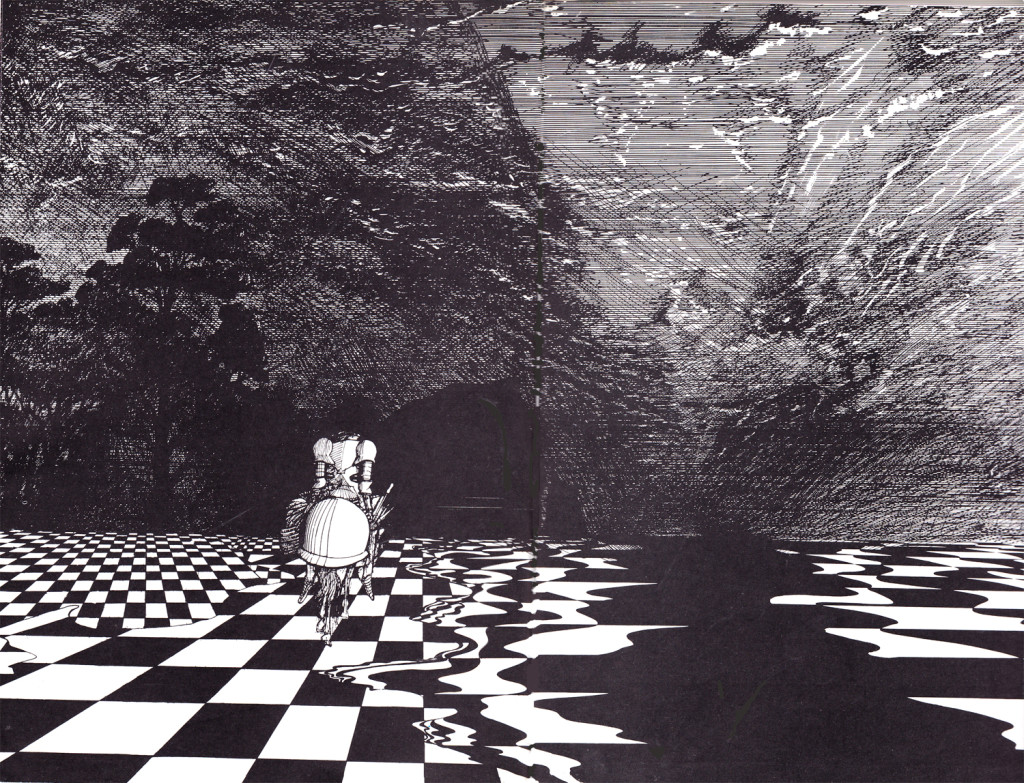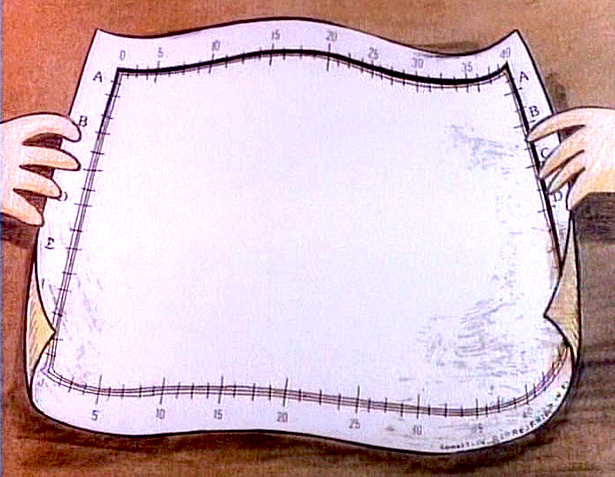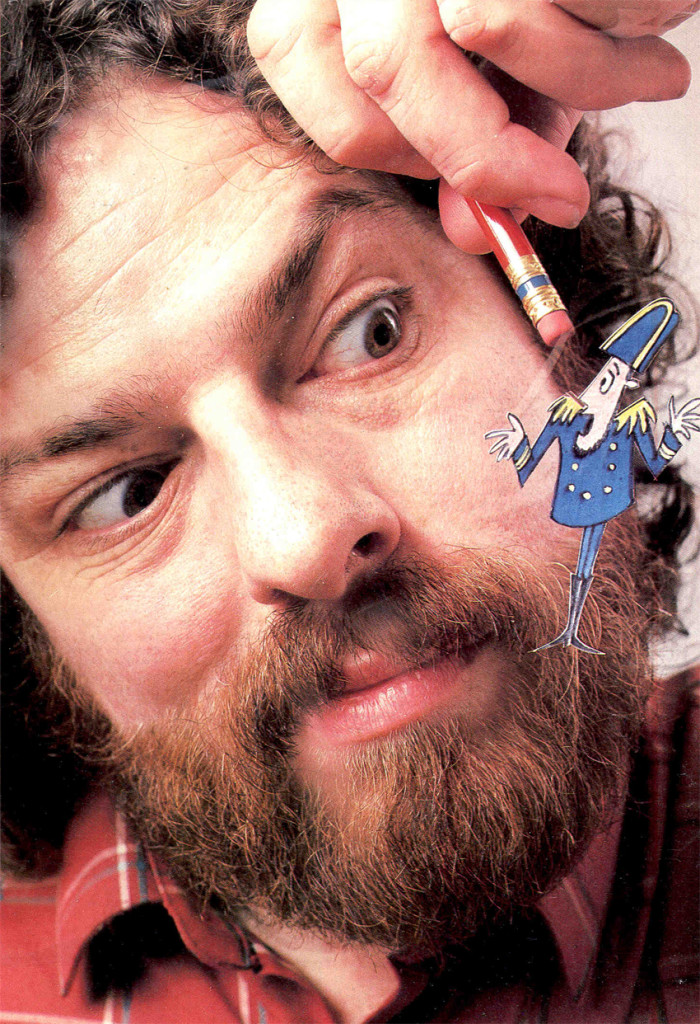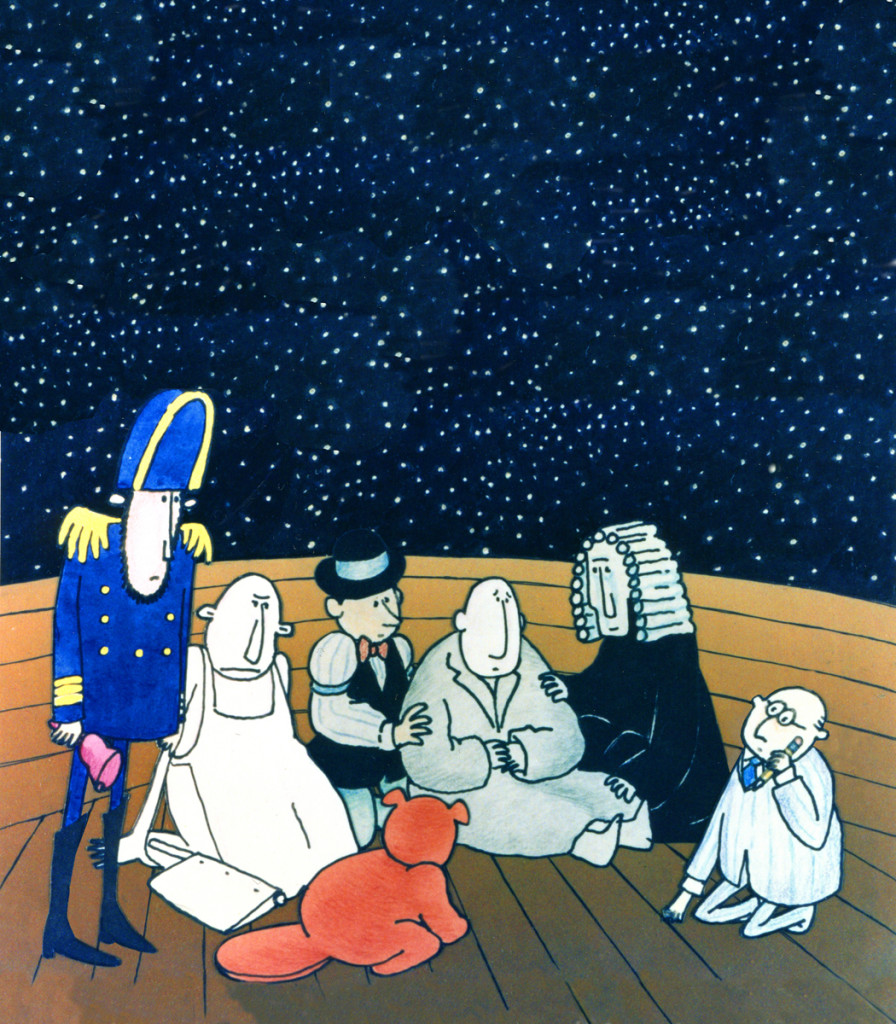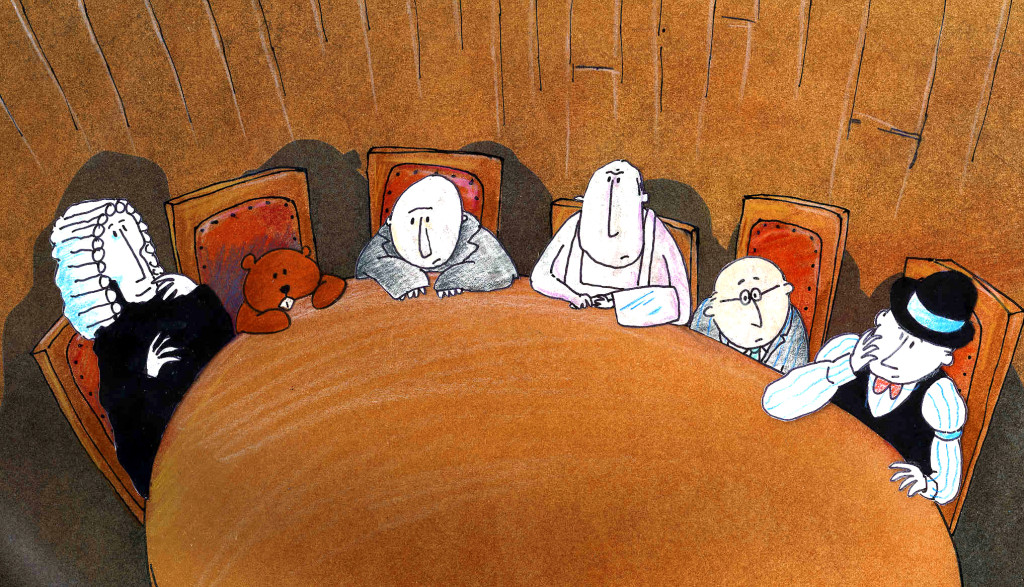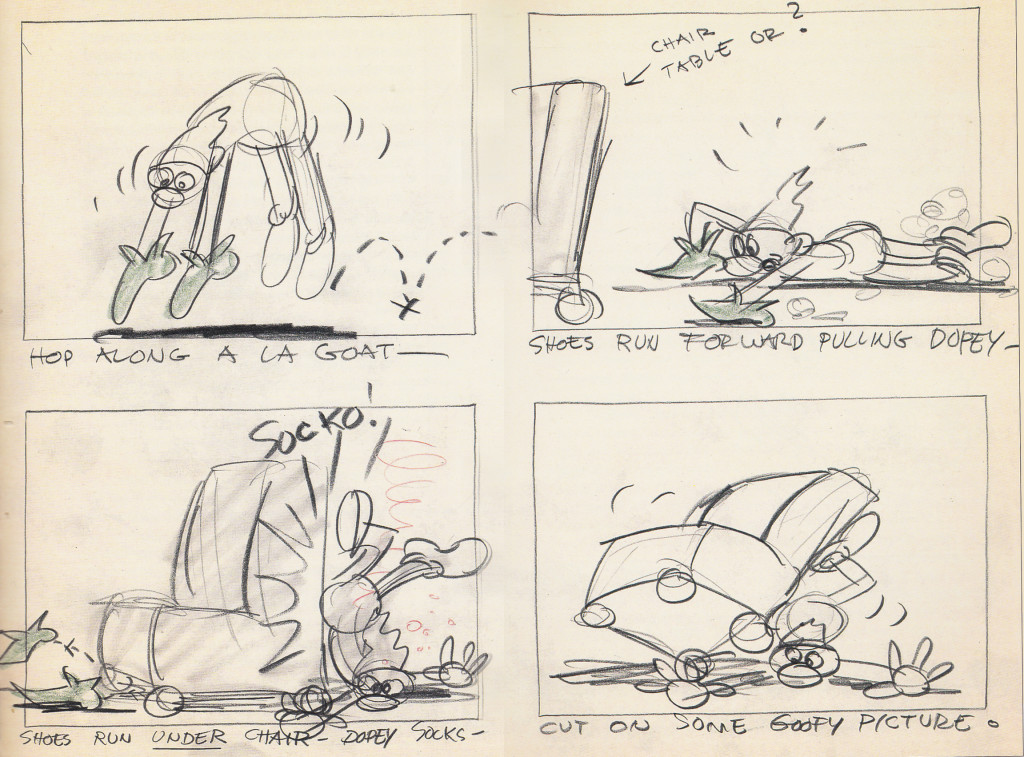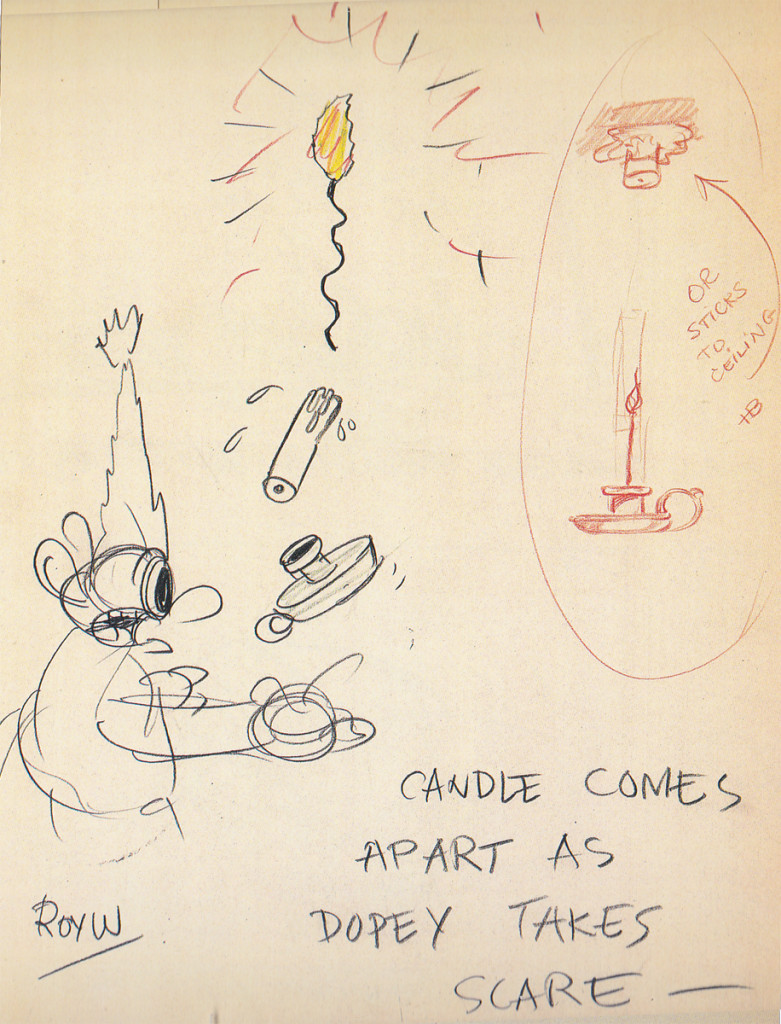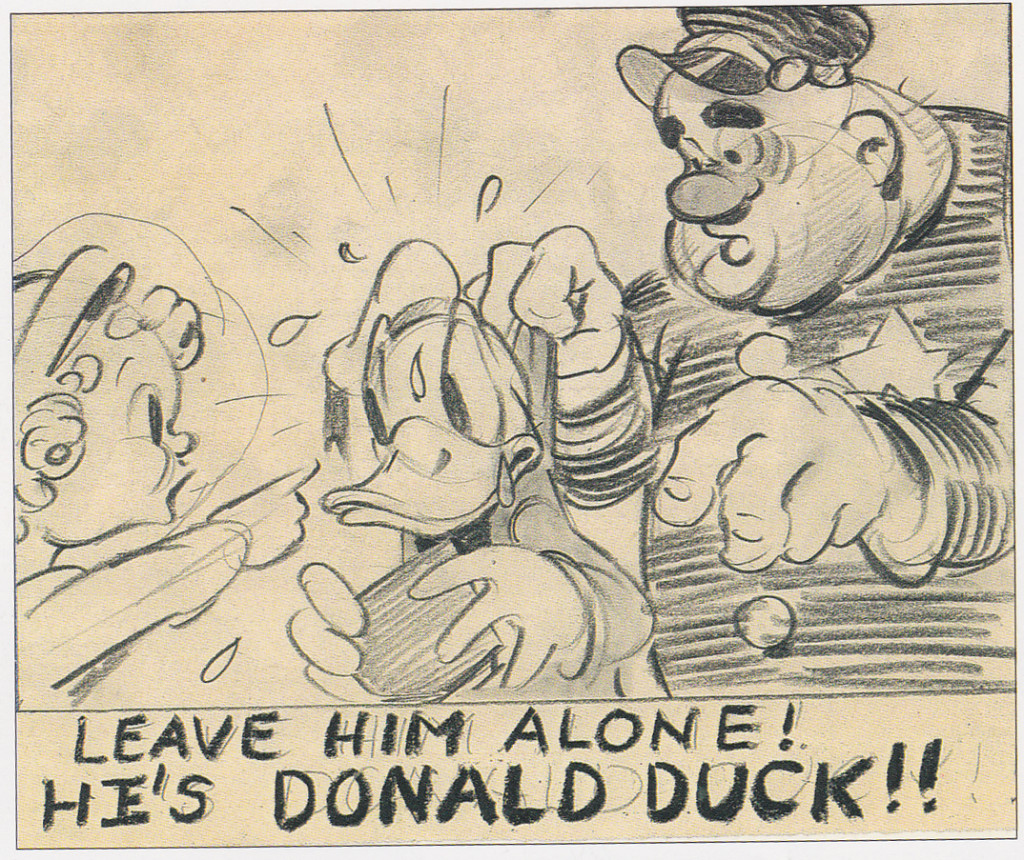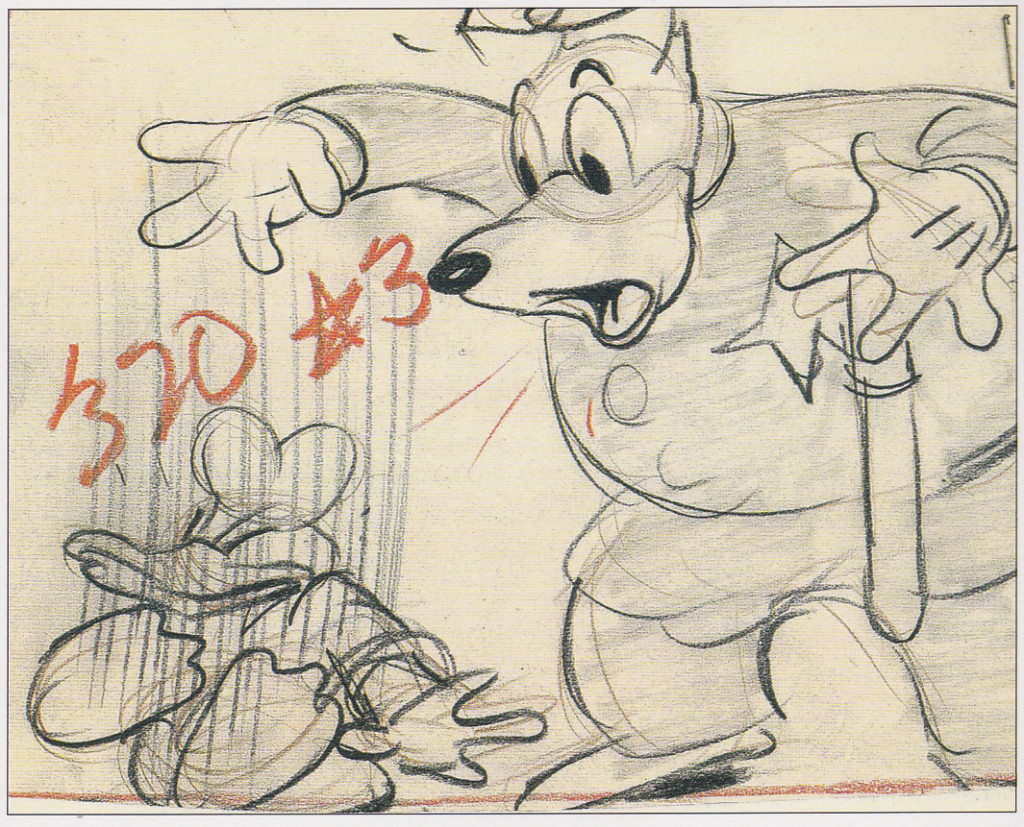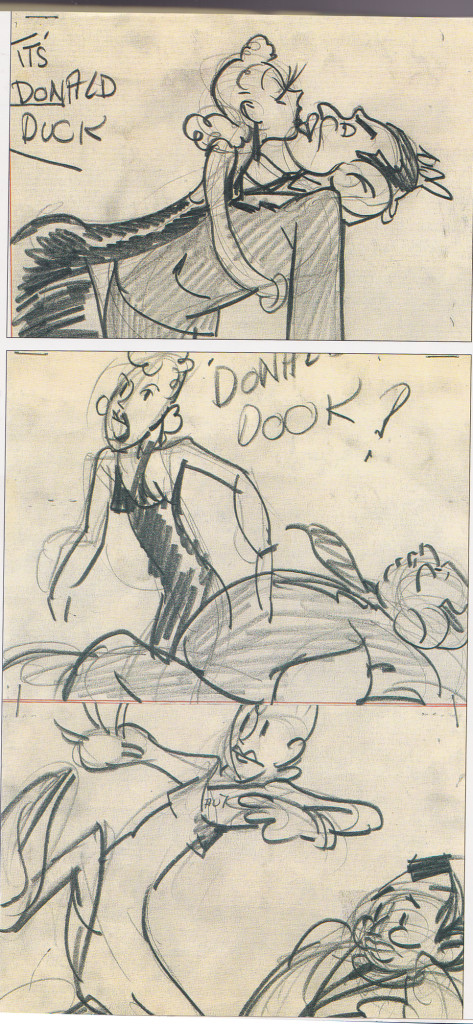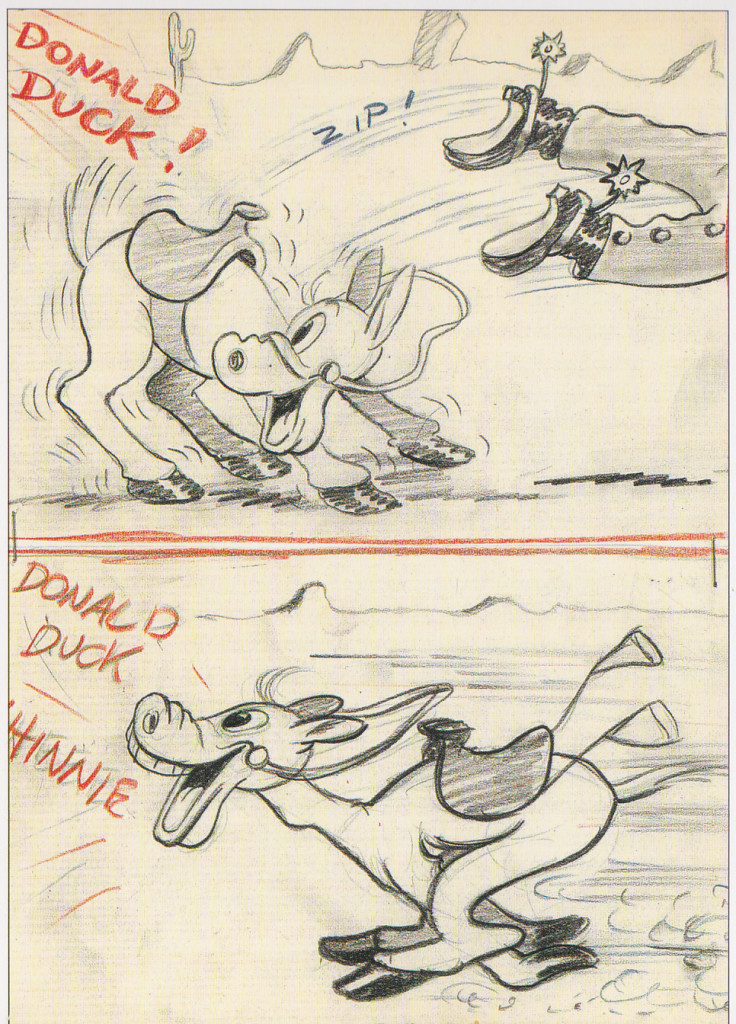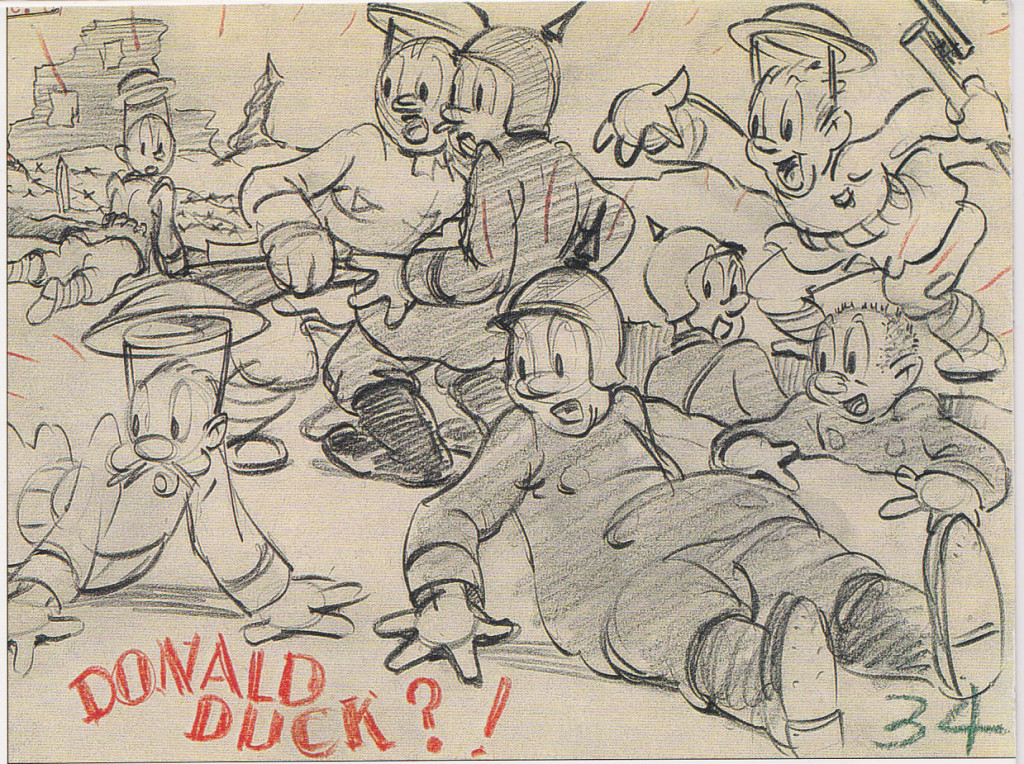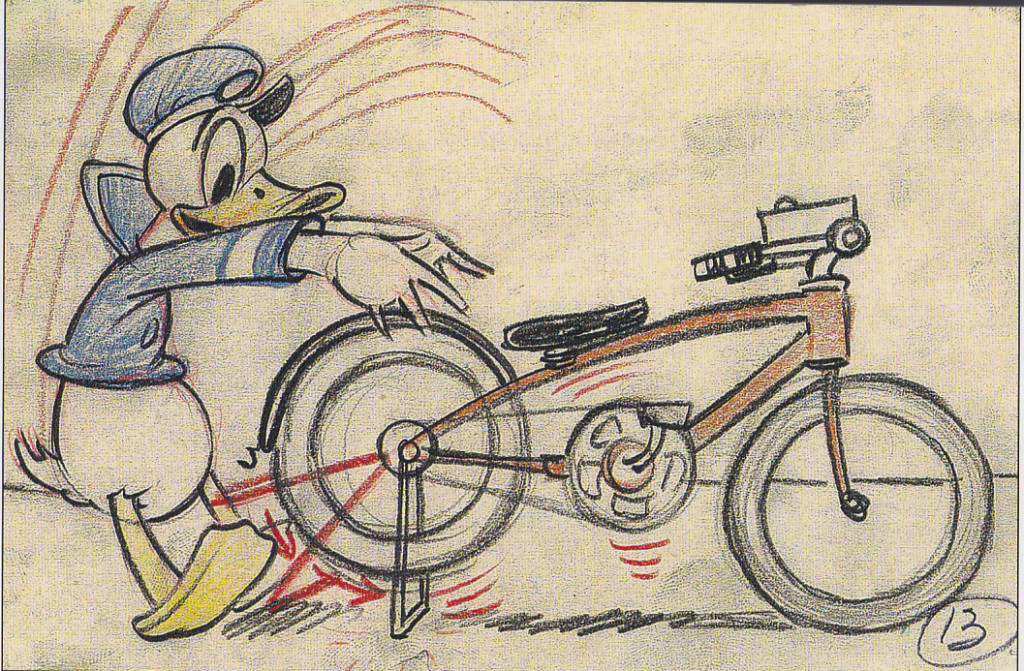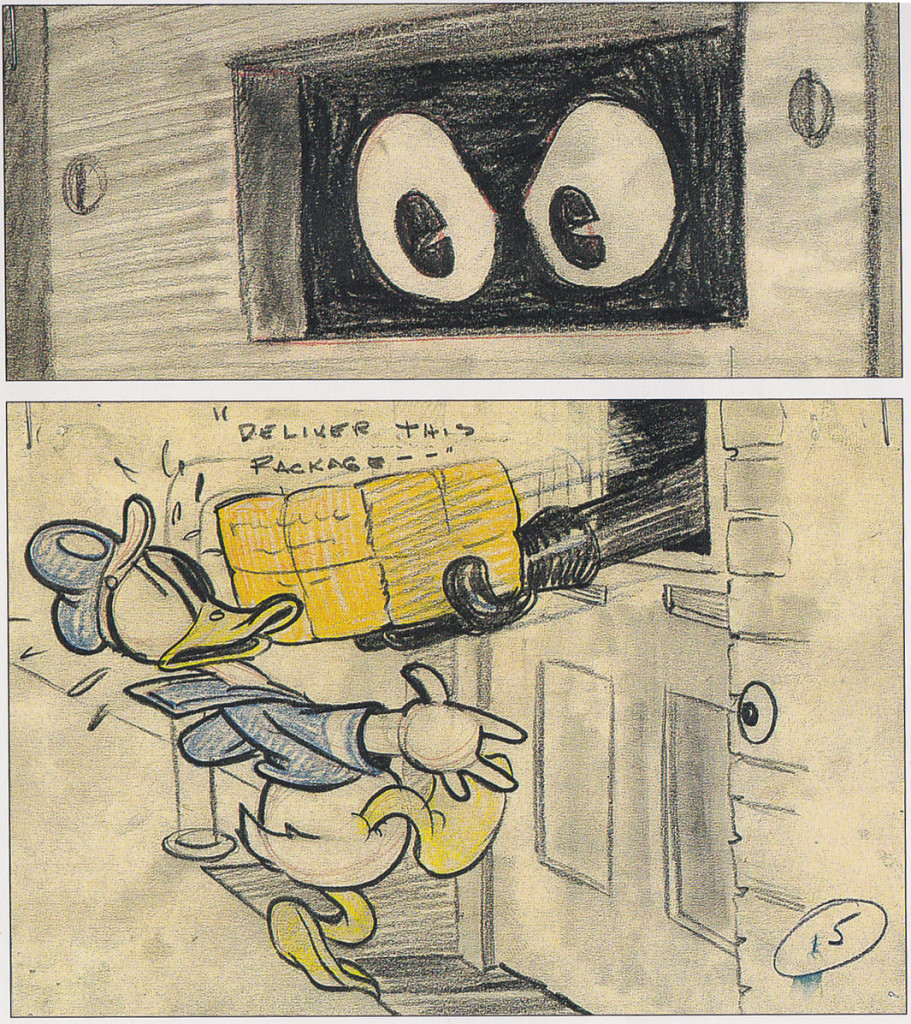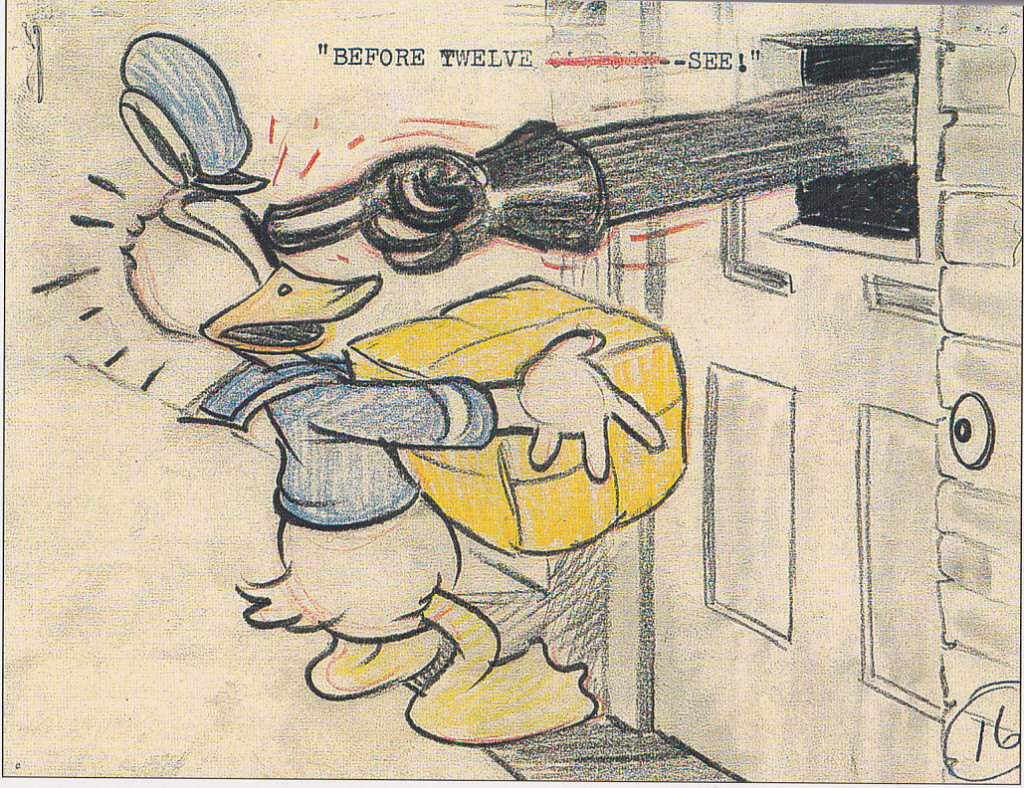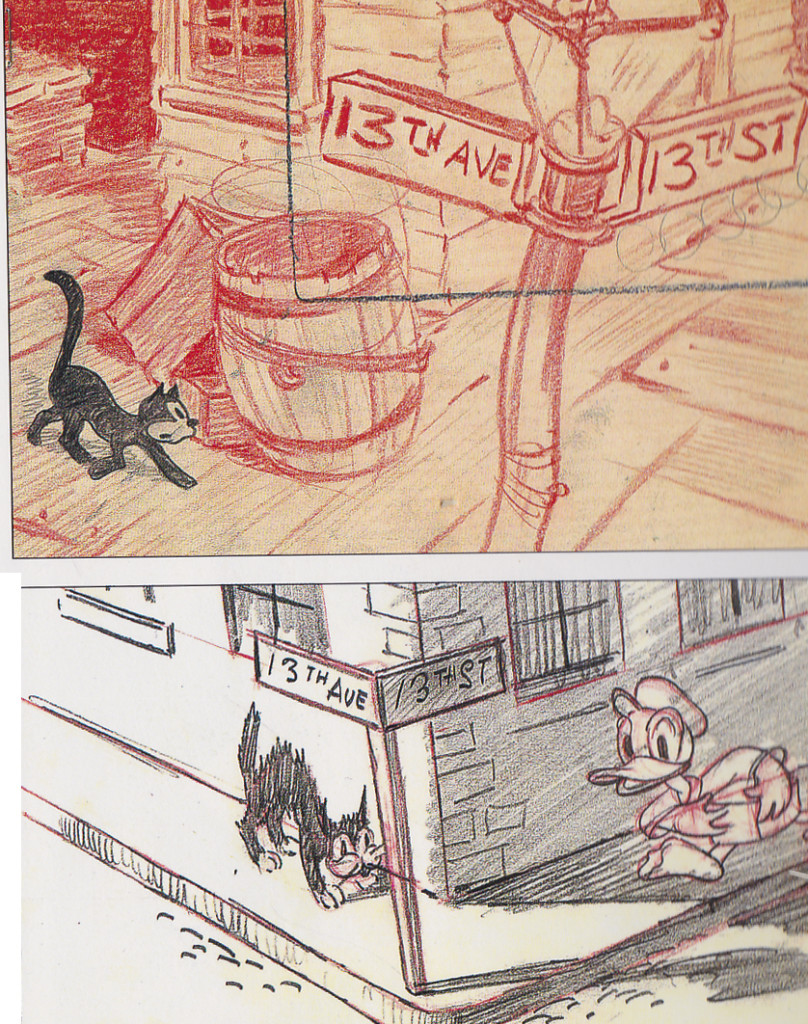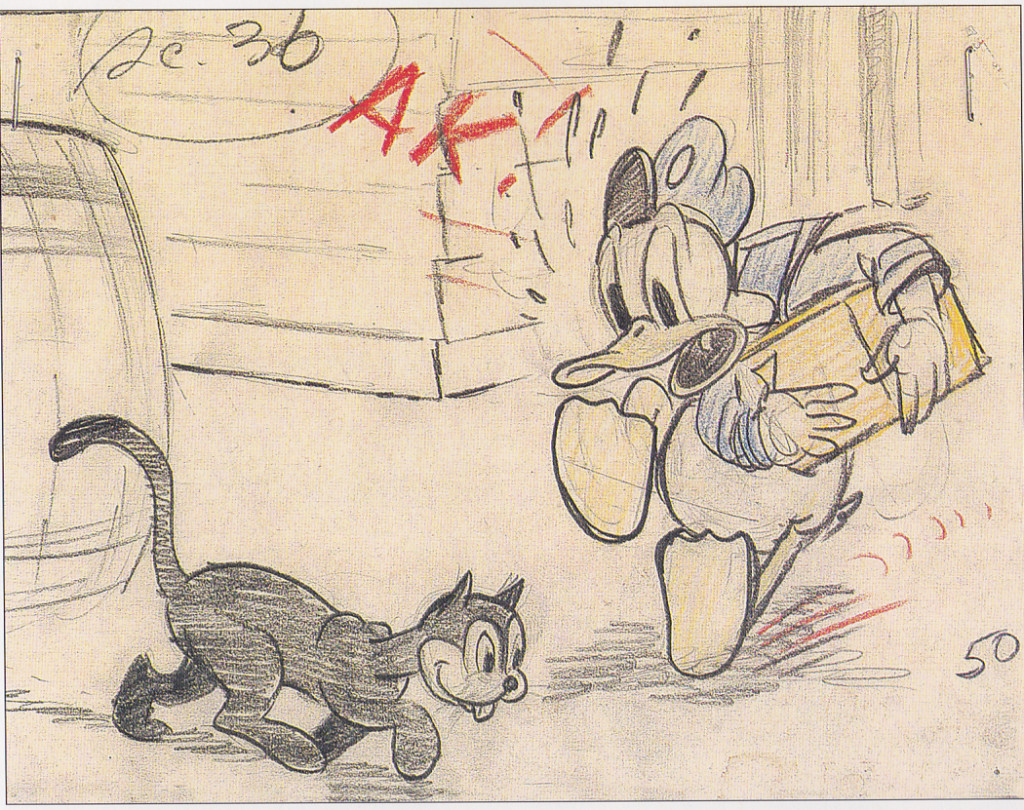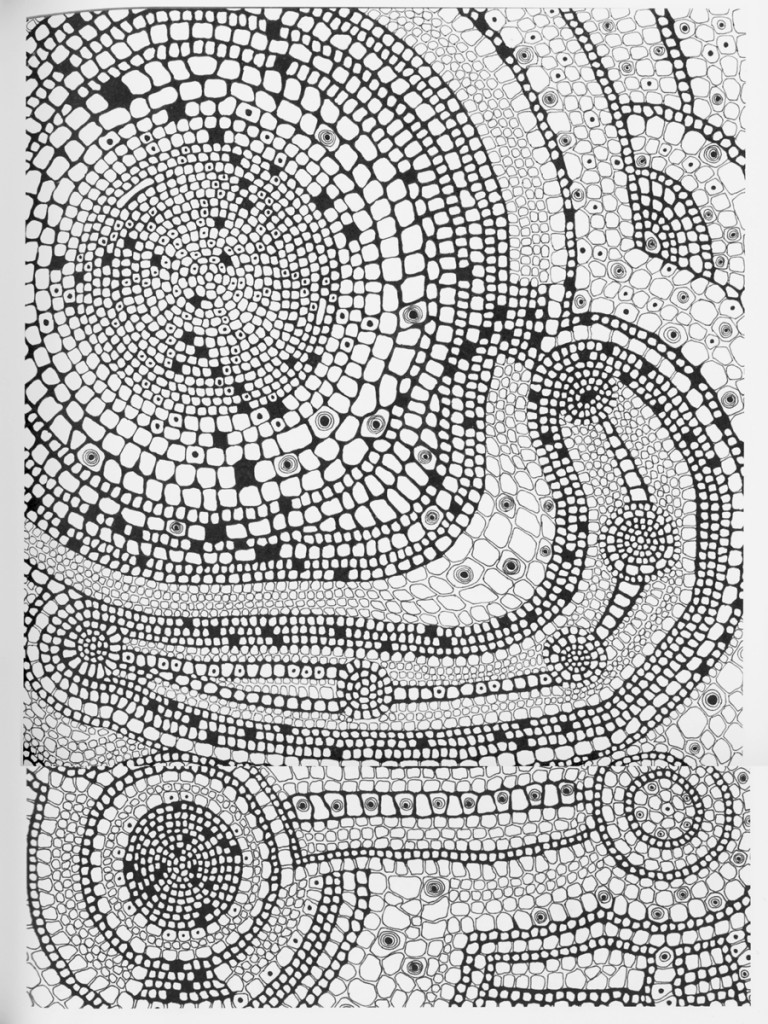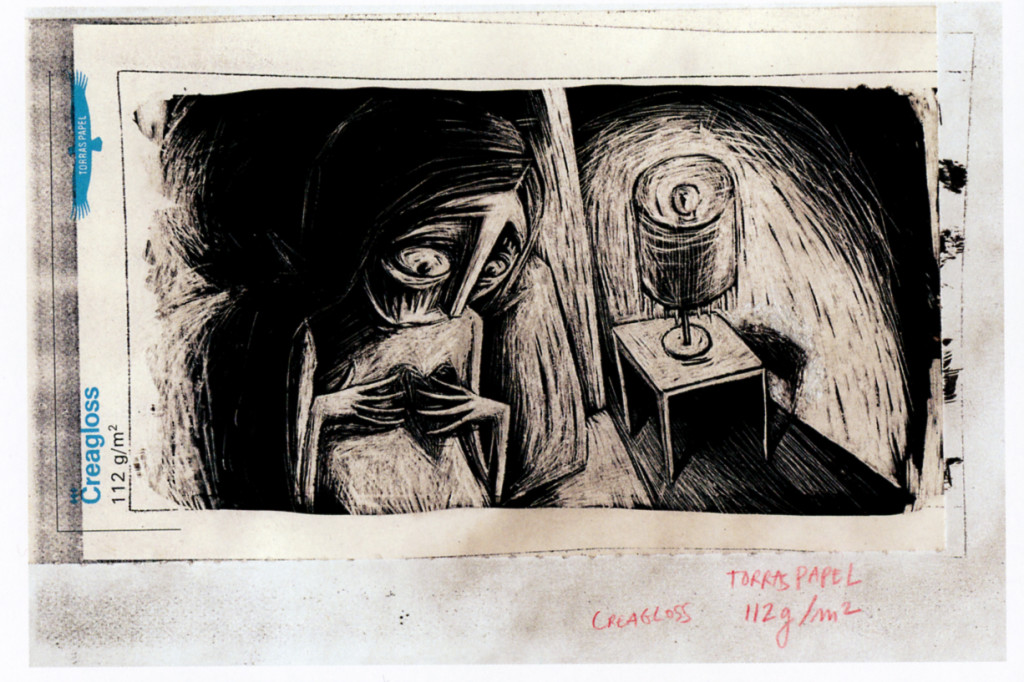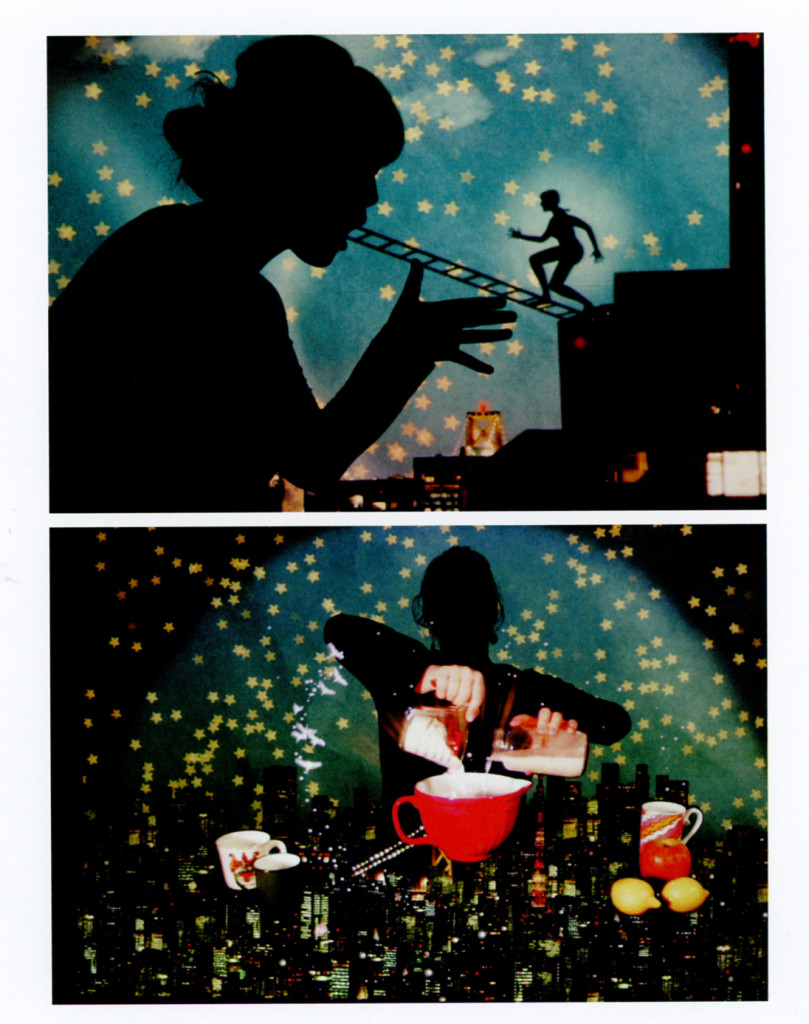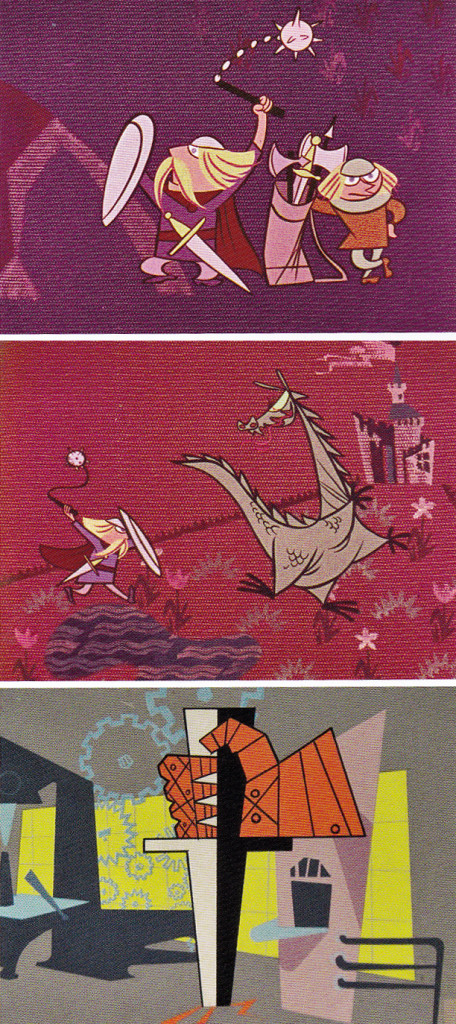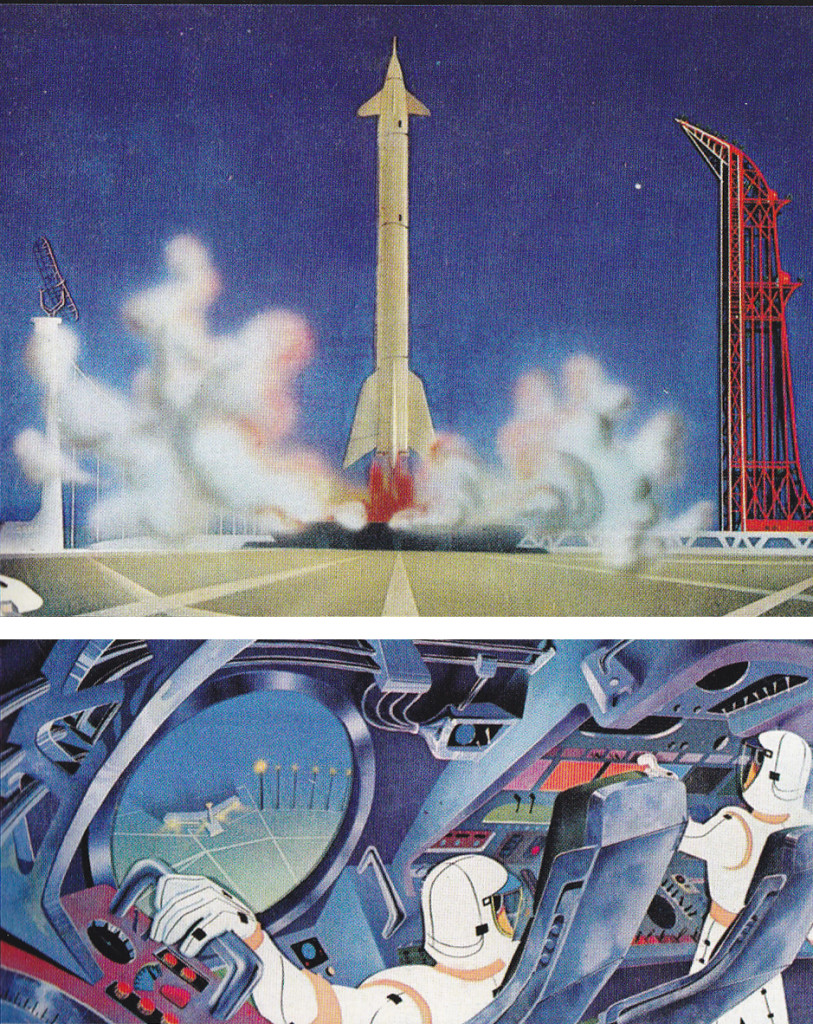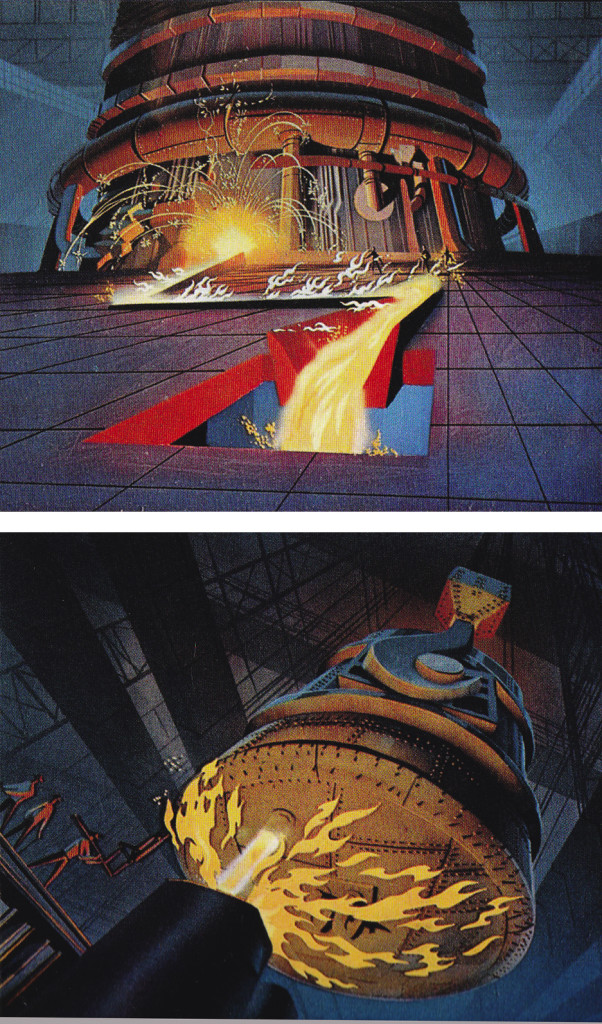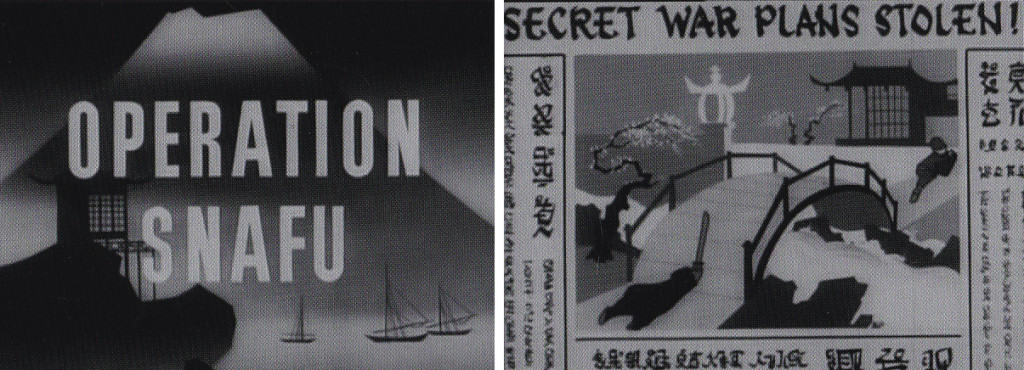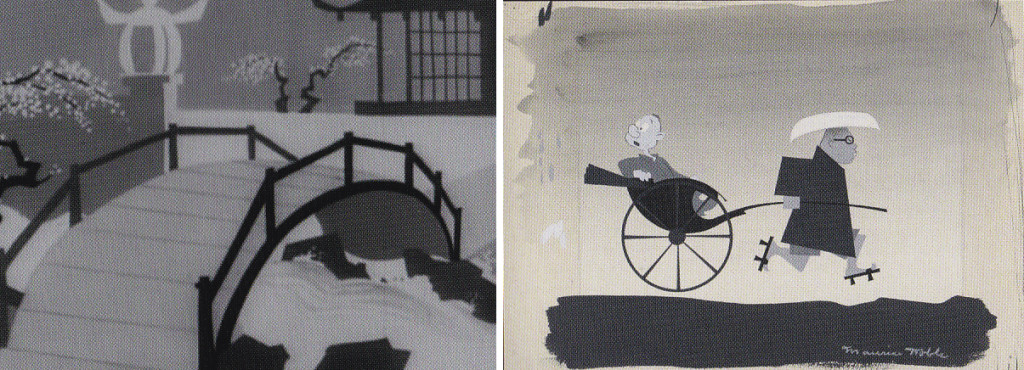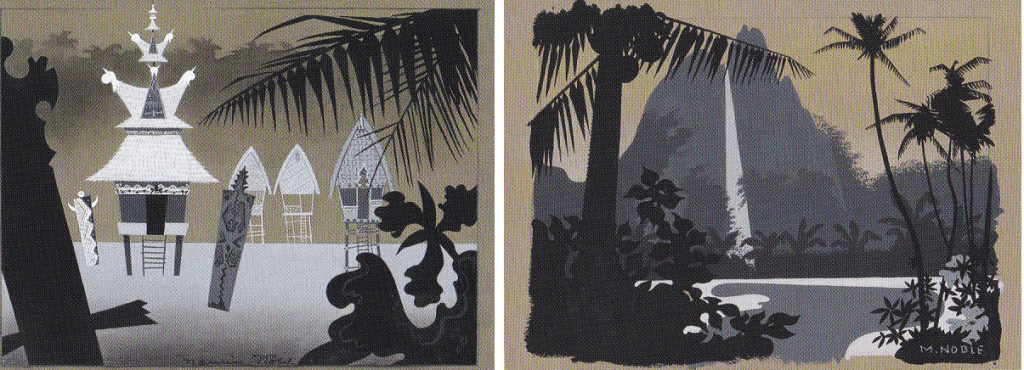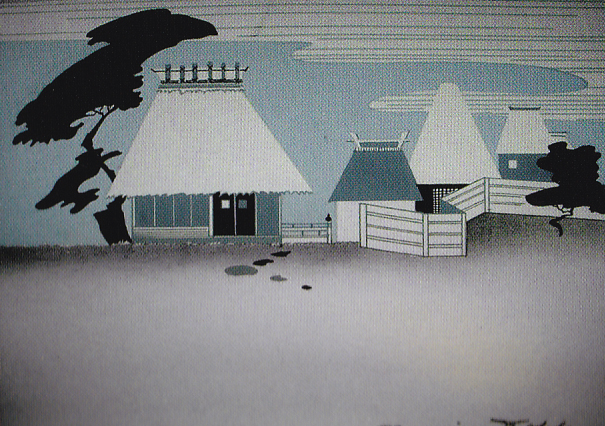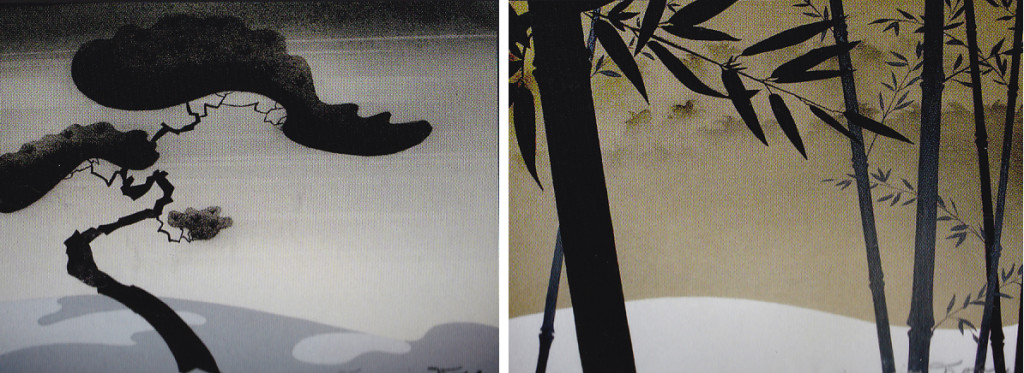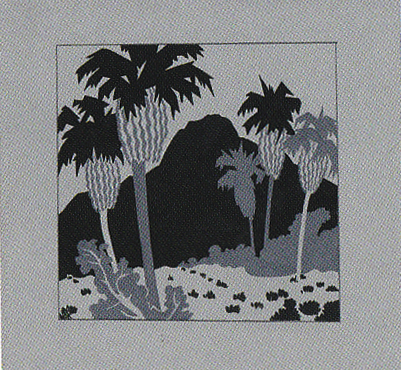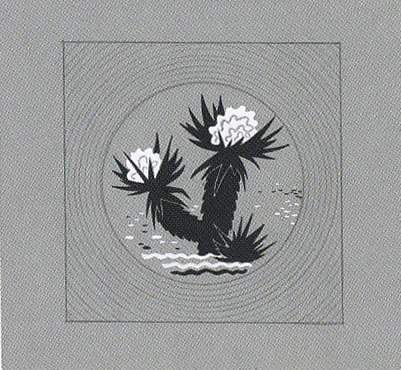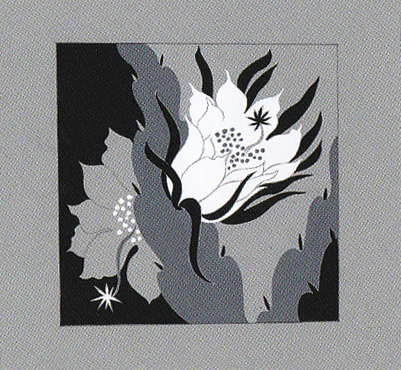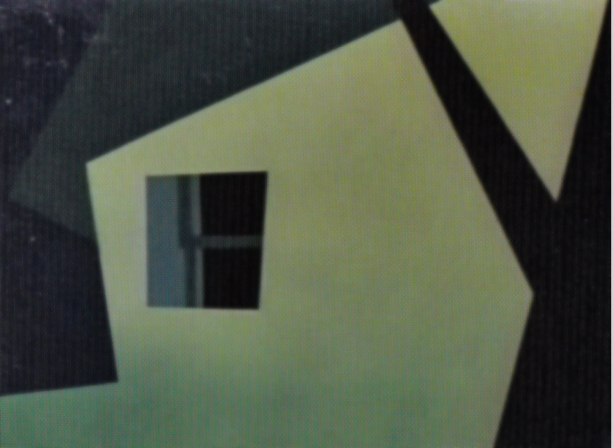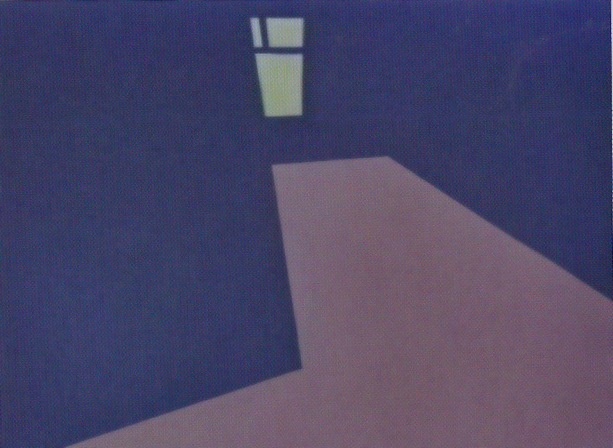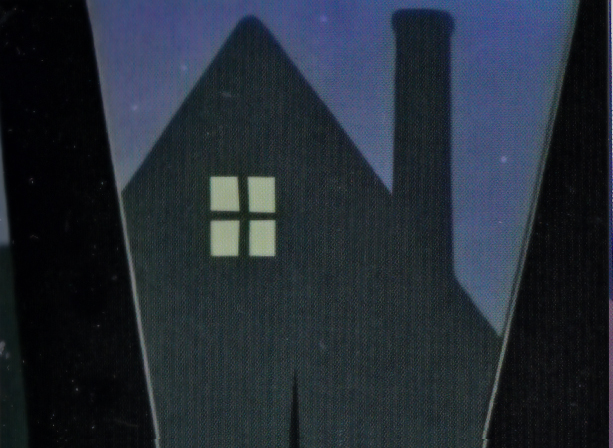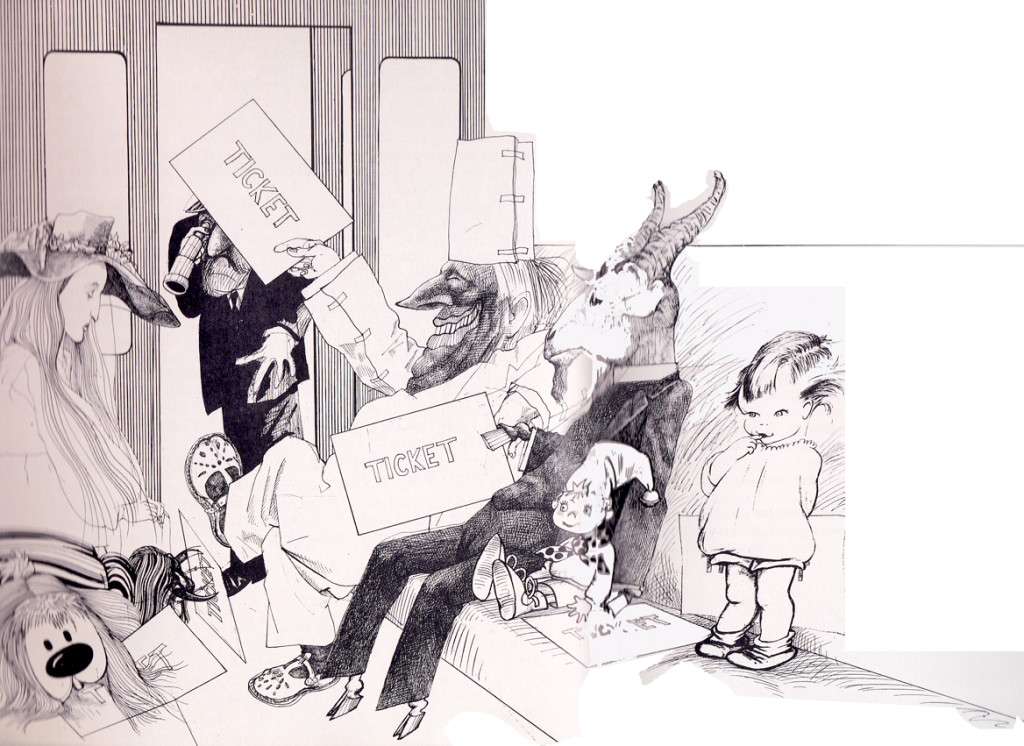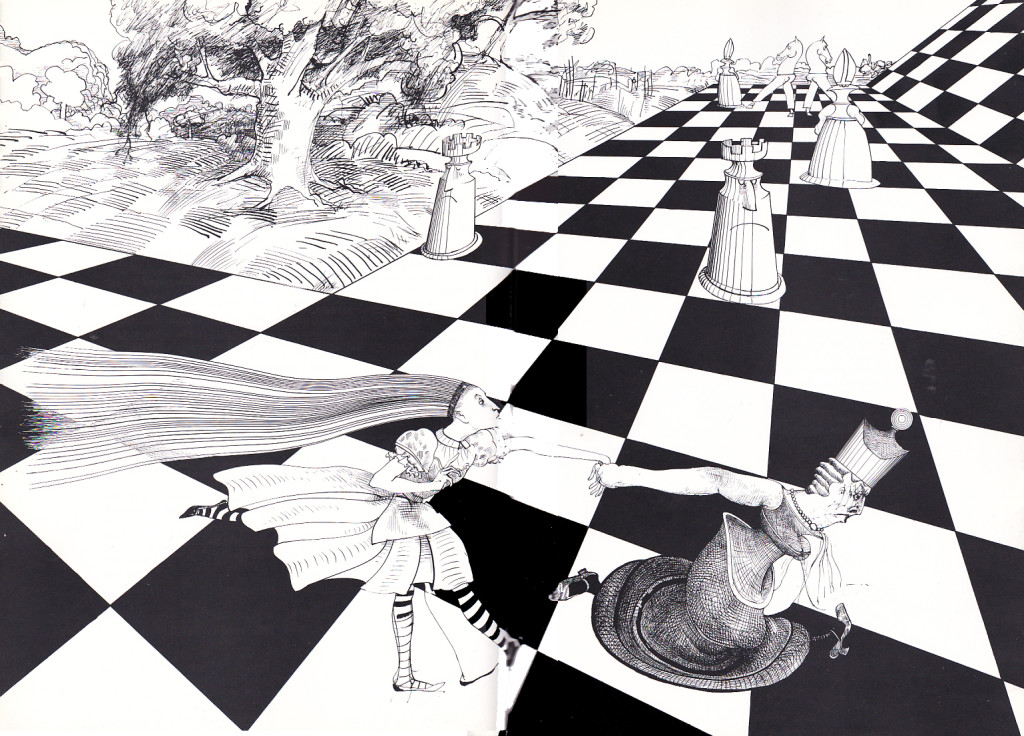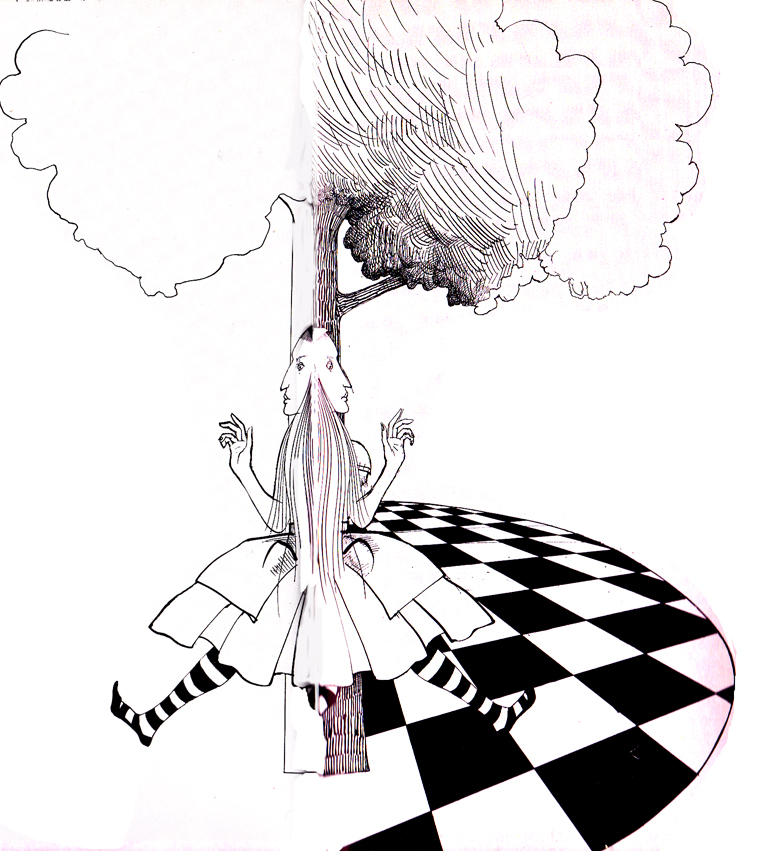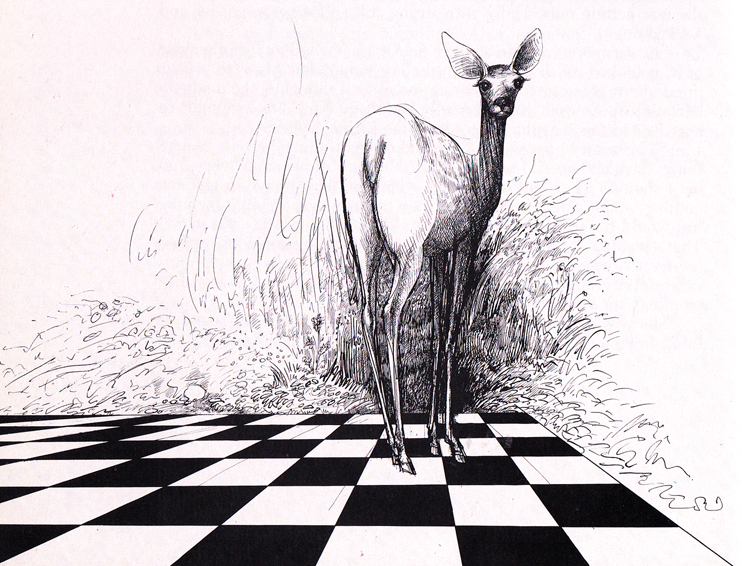Category ArchiveBooks
Animation &Books &Disney &Illustration 09 Nov 2013 02:31 pm
Waking UP
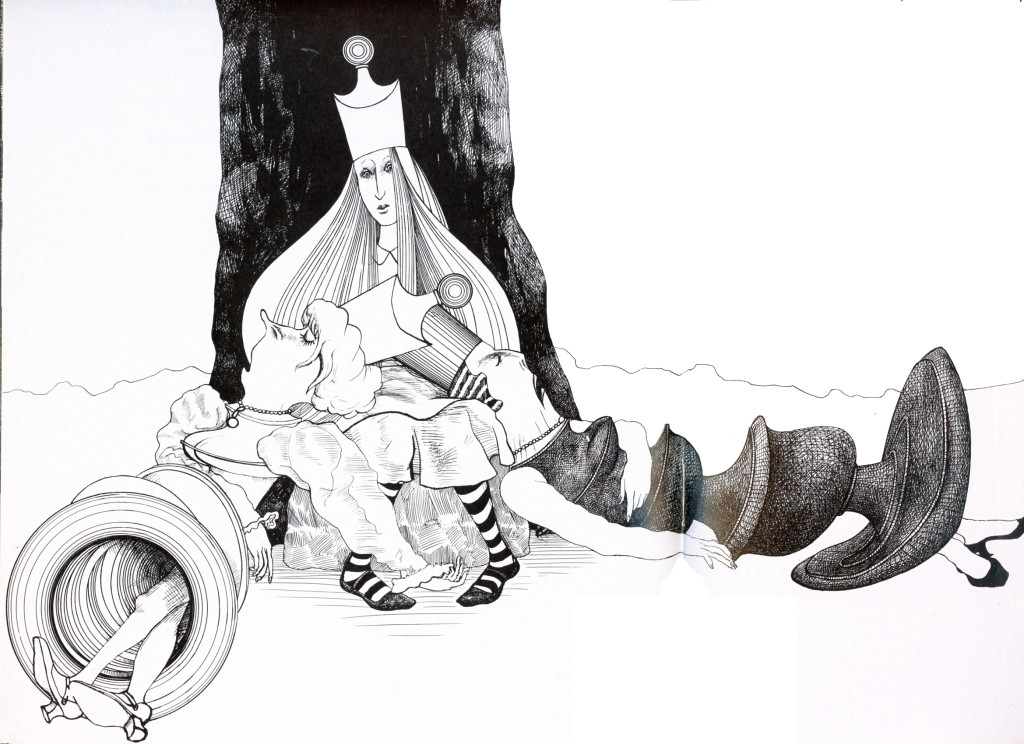 1
6
1
6I’m still Here by Tom Waite and Kahleen Brenan
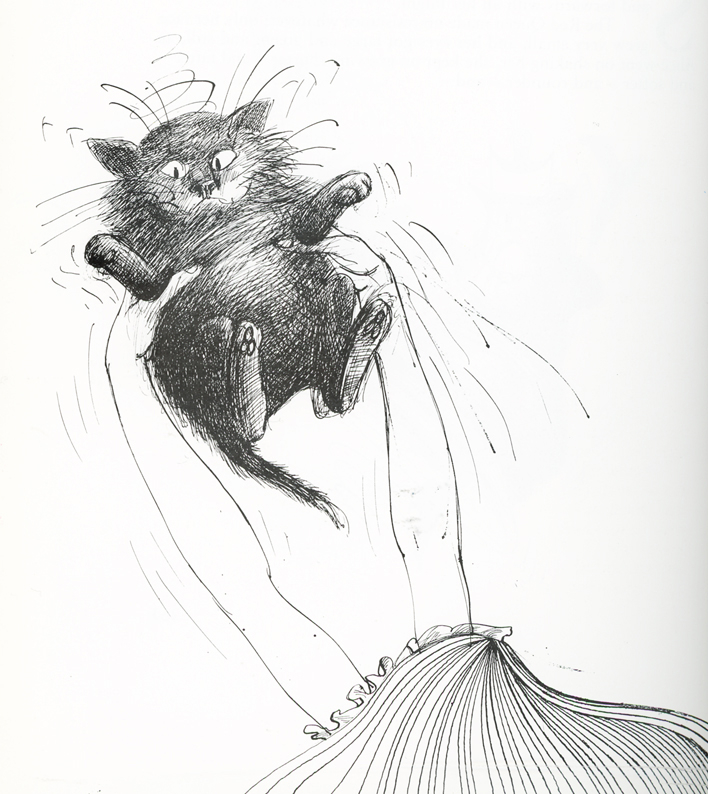 7
7
You haven’t looked that way in years you dreamed me up and left me here.
 8
8
How long was it you wanted me for you haven;t looked at me that way in years.
 9
9
Your watch has stopped and the pond is clear.
 10
10
Someone turn the lights back on I’ll love you til all time is gone
 11
11
You haven’t looked atr me that way in years.
 16
16
Song from Alice by Robert Wilson. Song by Tom Waite and Kathleen Brennan]
Books &Commentary &Illustration 22 Oct 2013 06:20 am
Steadman meets Jabberwocky
Ralph Steadman has reached the White Knight, who gets to recite Jabberwocky for the first time.
It’s a brilliant delight, of course, and the illustrations are completely up to the task. But this is from a wholly different book. (It’s published out of order within this volume. If it weren’t out of order it’d be too long to fit dramatically, here.) I believe I may have once posted Jabberwocky or some of it, anyway. I can’t find it just now. I also have the version by QUentin Blake which I know I didn’t post. (THAT book is a rarity.) I really do love Lewis Carroll’s work.
Soon after the White Knight is defeated by the young, imbalanced Red Knight (don’t ask, read it), the Red Knight tries to recite his poem but has a bit of difficulty. He has to keep time with his right hand while trying to stay in balance on his horse.
However, he keeps falling off the horse when his isn’t reciting. The man has a problem.
Tell me, don’t you think the Red Knight looks a bit like a young Prince Charles? My thought, of course. Would Steadman be that rude to treat his royalty so?
Here, uninterrupted, are the illustrations:
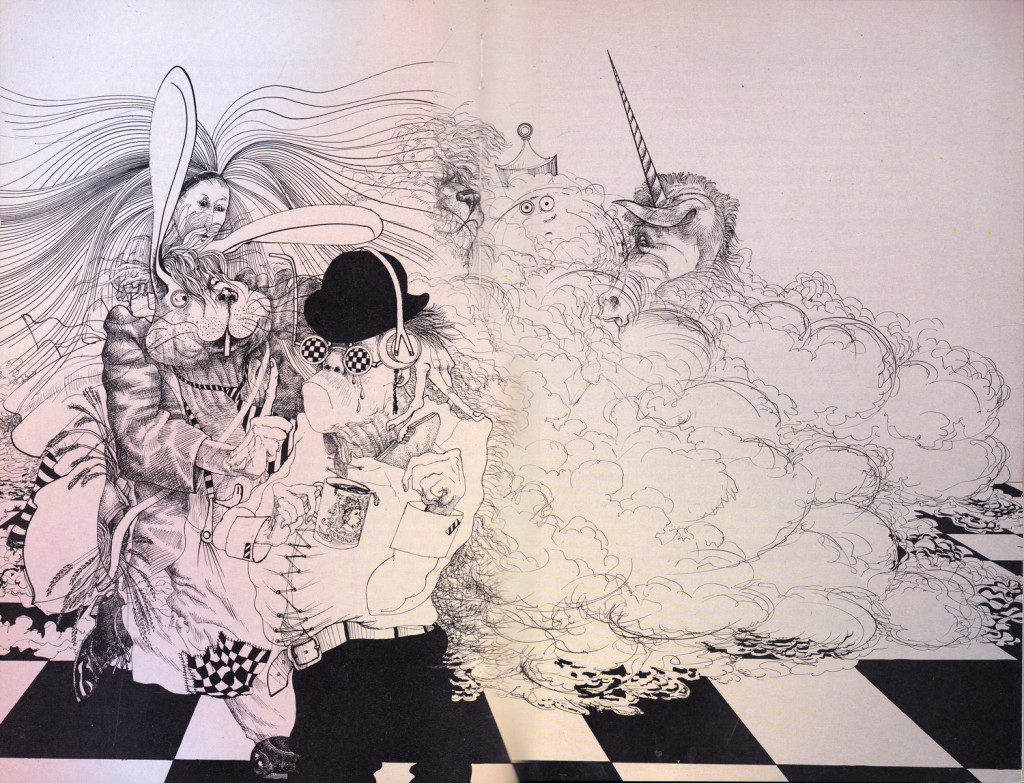 1
1
Starting today, I’m going to end a lot of my posts with images from Michael Sporn Animation Inc films. I have to say, in all the years of making so many films, too infrequently have I posted pictures of the work we’ve been doing. It’s about time.
Michael Sporn
Sporn images
from
The Hunting of the Snark
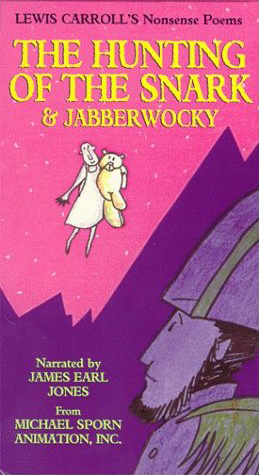
The individually wrapped video box from First Run Features 1
Books &Commentary 11 Oct 2013 06:40 am
The Writer, the man and Evermore
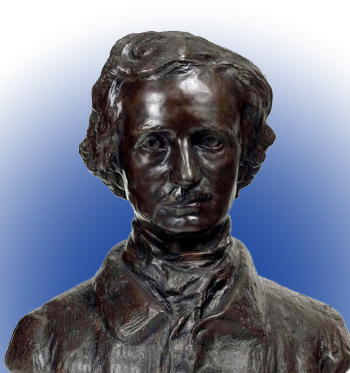 The Writer, the Man and Evermore; this is the subtitle given to Charles McGrath‘s recent article about the newly opened, exhibit celebrating the work of author Edgar Allan Poe. Having written a bit about this yesterday, I decided to go further. Of course I am excited by this news, having worked on Poe’s biography these past six years, with the purpose of creating a low budget animated feature. Poe led a very difficult life, completely impoverished, with almost all the women in his lifetime dying during on him – his wife, much younger than he, died of Tuberculosis. His mother also died of TB when Poe was just 3 yrs old. He was left an orphan of the State and was given to Thomas Allan and wife as surrogate parents. They abandoned Poe during his college years and he spent much of the rest of his life searching for funds to write. He lived with his aunt and married his cousin 27 years his younger. It was assumed they were more a brother-sister relationship rather than husband-wife. Since all three were inches away from pure penury, it made sense for them to live together with his acting as the family support. And, indeed, it was much of the writing that did give them financial aid. Several times he attempted to start a literary magazine, but was more often likely to be writing for one. Graham’s Reader was one such paper for which he wrote some strong material, including The Murders in the Rue Morgue.
The Writer, the Man and Evermore; this is the subtitle given to Charles McGrath‘s recent article about the newly opened, exhibit celebrating the work of author Edgar Allan Poe. Having written a bit about this yesterday, I decided to go further. Of course I am excited by this news, having worked on Poe’s biography these past six years, with the purpose of creating a low budget animated feature. Poe led a very difficult life, completely impoverished, with almost all the women in his lifetime dying during on him – his wife, much younger than he, died of Tuberculosis. His mother also died of TB when Poe was just 3 yrs old. He was left an orphan of the State and was given to Thomas Allan and wife as surrogate parents. They abandoned Poe during his college years and he spent much of the rest of his life searching for funds to write. He lived with his aunt and married his cousin 27 years his younger. It was assumed they were more a brother-sister relationship rather than husband-wife. Since all three were inches away from pure penury, it made sense for them to live together with his acting as the family support. And, indeed, it was much of the writing that did give them financial aid. Several times he attempted to start a literary magazine, but was more often likely to be writing for one. Graham’s Reader was one such paper for which he wrote some strong material, including The Murders in the Rue Morgue.
Presumably, according to Mr. McGrath a lot of manuscripts, letters, and the life are on display. Given the extensive work that several other organizations have done, it’s helpful to have this material preserved for public consumption. (I keep promising to get myself to the Poe House up in the Bronx but I’ve missed that train for too often to not feel the guilt of my actions.) We have in the script for the feature a short sequence wherein two well know ladies – friends of the Poes – visit. They play some sort of early football in the yard only to end when Edgar’s shoe completely dissolves after smashing the ball. Since he had no other shoes, the guests chipped in to buy him a new pair.
Please, don’t mind me. I’ve gotten so addicted to Edgar Allan Poe’s work that I have a hard time not talking about it. I thnk, in some ways, I see a lot of similarities in our lives. That money thing was always the patch blocking the middle of the road. I need a lot more than he did to get my “art” going, but in the end it ma as well be the same thing.
I also recognize that unwittingly I have the same sense of arrogance about mine own artform. I so fussy about wanting what I want that I can be hard to put up with after screenings. I’ll tell you after seeing “Tangled” I was hard to live with. I hated the film and was upset with all those who’d worked on it. It was stupid; I’d seen a lot worse and even enjoyed a lot worse. I just couldn’t deal with those lead characters and, though I liked the horse, I couldn’t help but see Prince Phillip’s horse (Milt Kahl’s character in Sleeping Beauty) in cg. It just never made the grade for me.
Boy, am I looking forward to the day when I can give my full support to that POE film. It really will be some kind of adult film, but today, I can only visit the art exhibit planted so nearby my own home. Even that’s a pricey affair, so getting in to see it will take some financial maneuvering. But I wouldn’t miss it.
Animation Artifacts &Books &John Canemaker 08 Oct 2013 02:17 pm
a Coupla Board Gag-stas
Aside from formulating the inventors of the storyboard for animation, the Disney studio had some amazing talent in their group of “funnymen.” Most of the “gag writers” that took over the animation industry, came 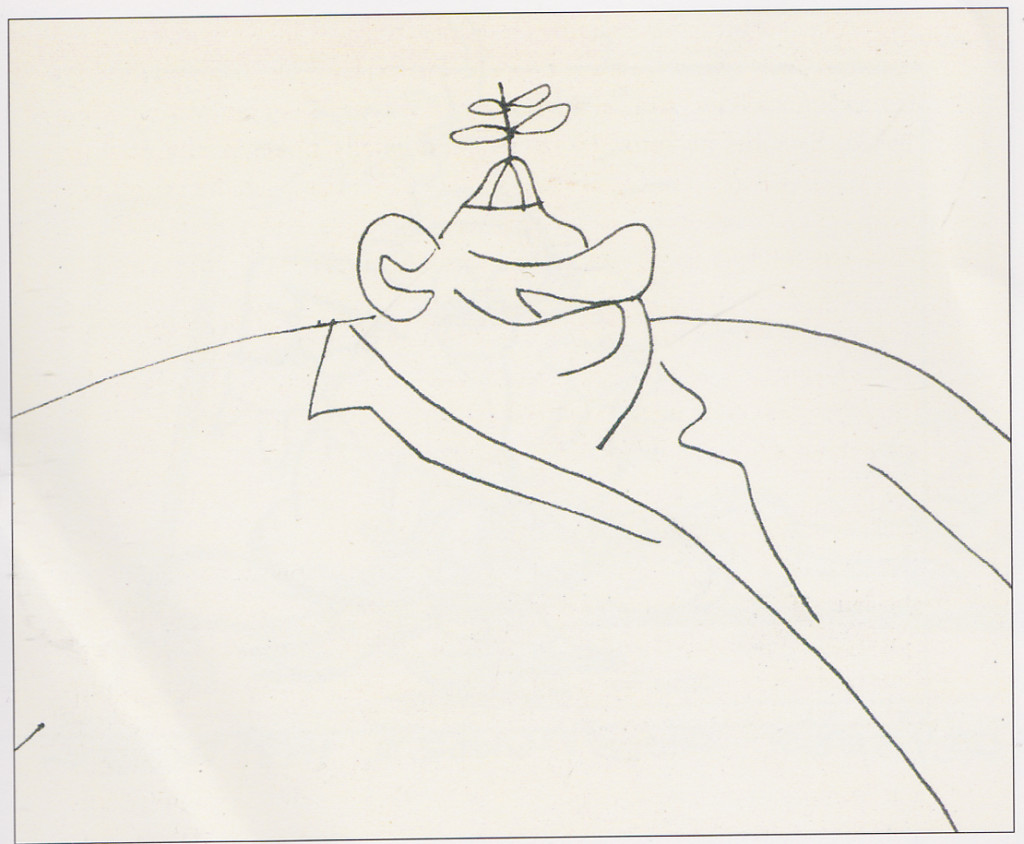 fresh from the Disney Bros. studio. You can start with Dick Huemer who virtually invented the form. There was Tedd Pierce who brought his own style and a rich sense of humor. Between him and Bill Peet there were a wild row of styles and intelligence from the Urbane to the Hayseed.
fresh from the Disney Bros. studio. You can start with Dick Huemer who virtually invented the form. There was Tedd Pierce who brought his own style and a rich sense of humor. Between him and Bill Peet there were a wild row of styles and intelligence from the Urbane to the Hayseed.
Here I’d like to show two of the richest and most colorful artists.
First we have one of the better “dwarf” writers – Roy Williams, Many of us know him as the oversized and goofy “Mousketeer,” Uncle Roy. This is a small piece done for Snow White, trying to get a gag out while giving some personality to Dopey.
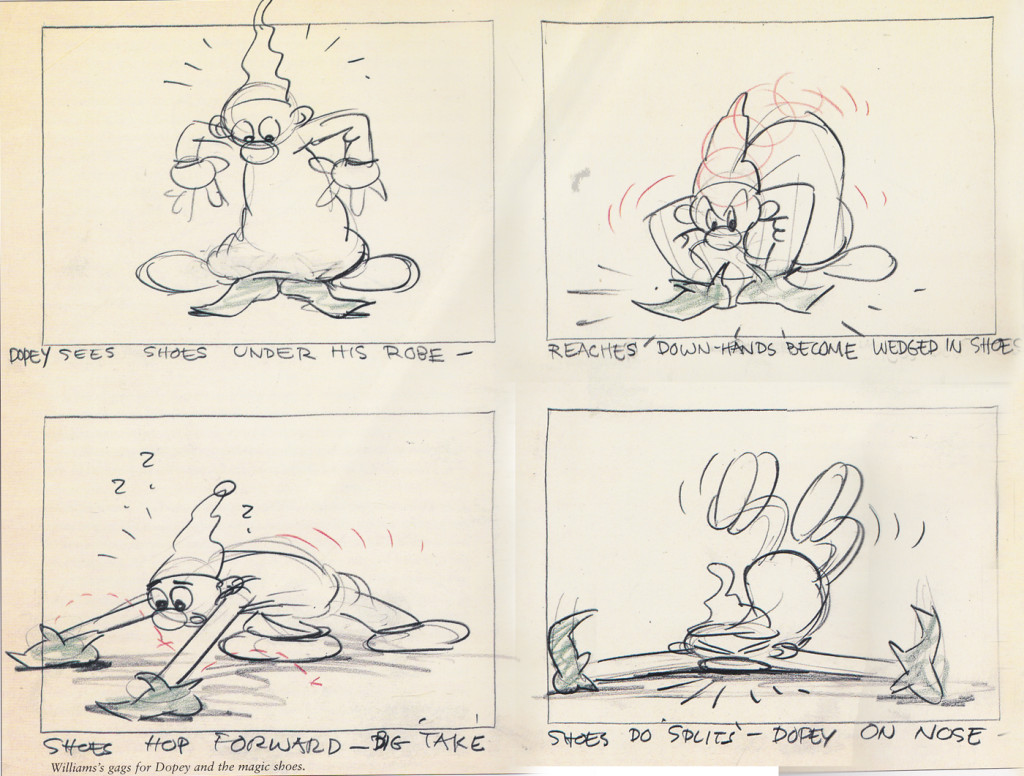 1
1
From “Unca Roy,” we can go to one of the most identifiable artists from the studio. Just take a look at the last two images posted here. If you don’t recognize the gag as one from the pen of foremost Donald cartoonist, Carl Barks. If not for some of the gags, here, the drawing style is dead giveaway. One can only sit back gawking at how great it is.
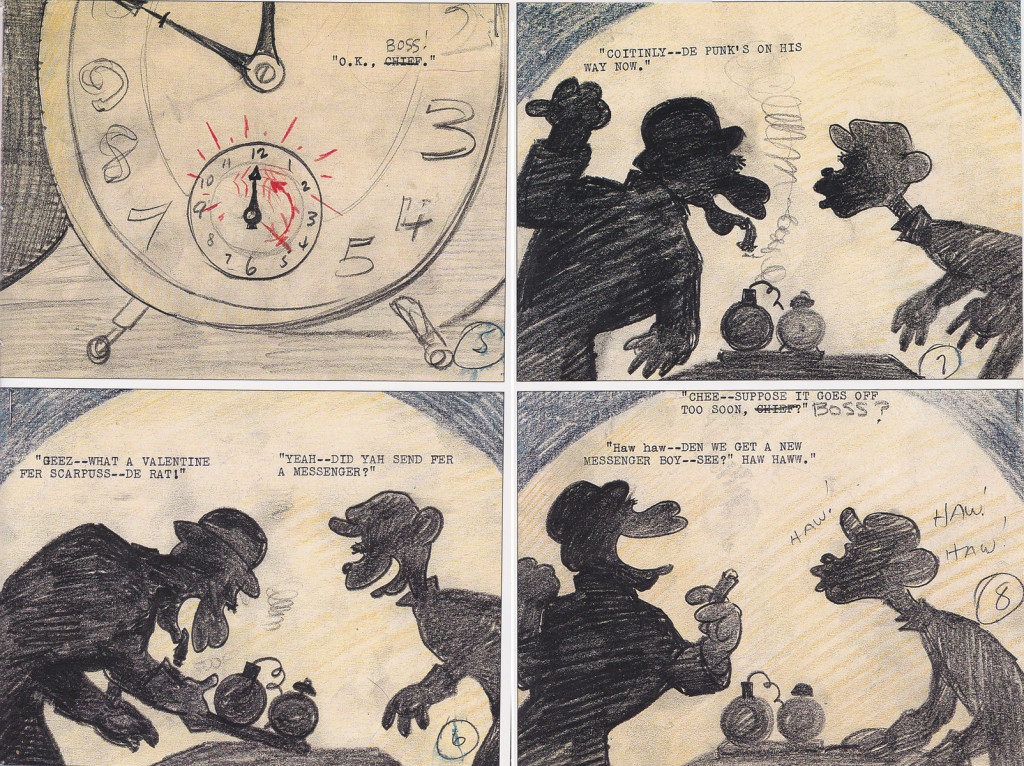
I will show off the work of a couple more of these great artists before I’m done. They keep me laughing all the while admiring them.
All material thanks to John Canemaker whose brilliant book, Paper Dreams, supplied just about everything for this post.
Books &Commentary &Layout & Design 27 Sep 2013 06:33 am
More Sketchbook Work
I’d like to continue here with more of the Animation Sketchbook drawings that appear in that beautiful Chronicle book, “Animation Sketchbooks.” I will just jump in with more illustrations done by these world-wide animators.illustrators.
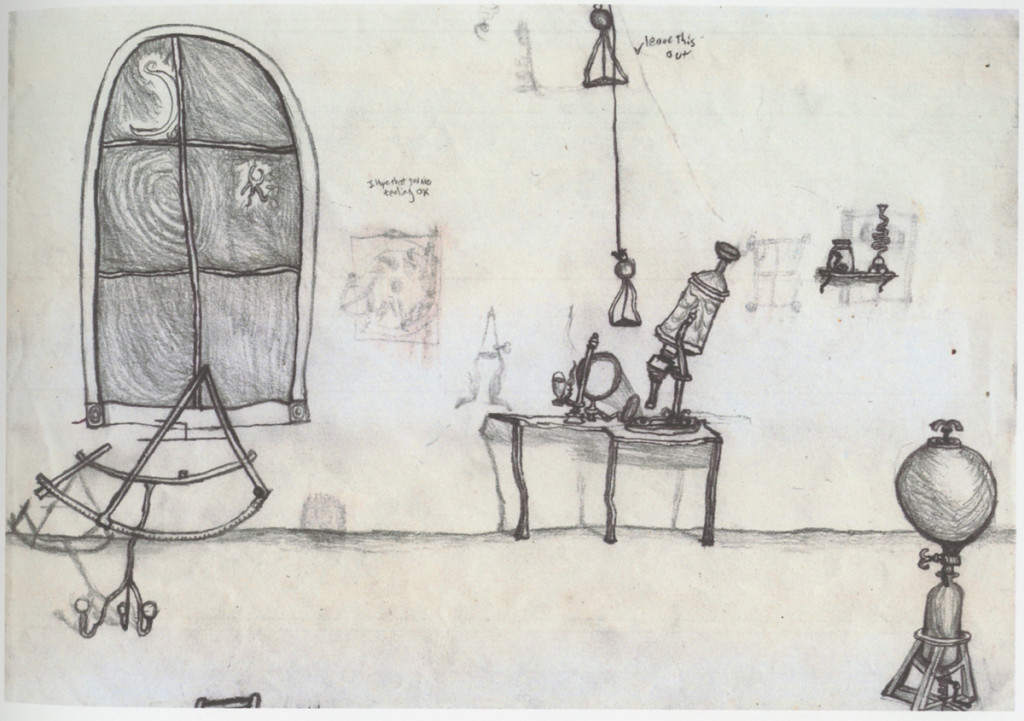
Brent Green Stybd for Chesternut
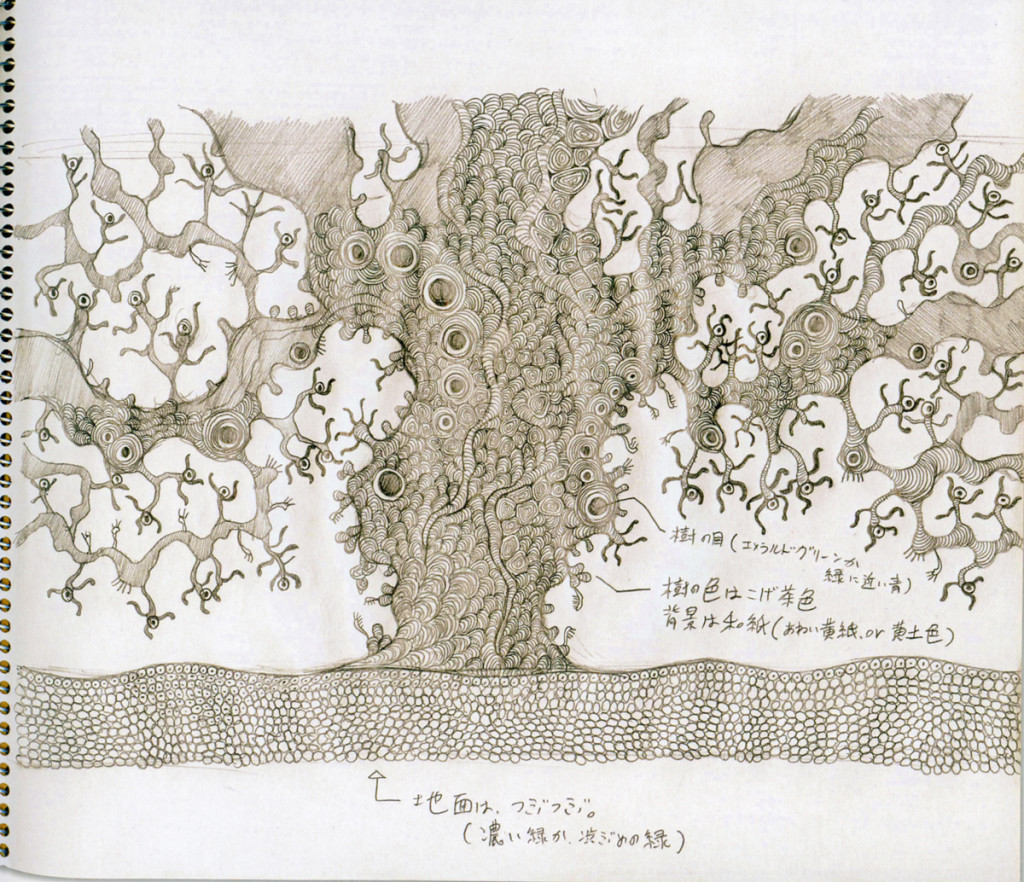
Miraj Majui Sketch for children’s TV WOWW.
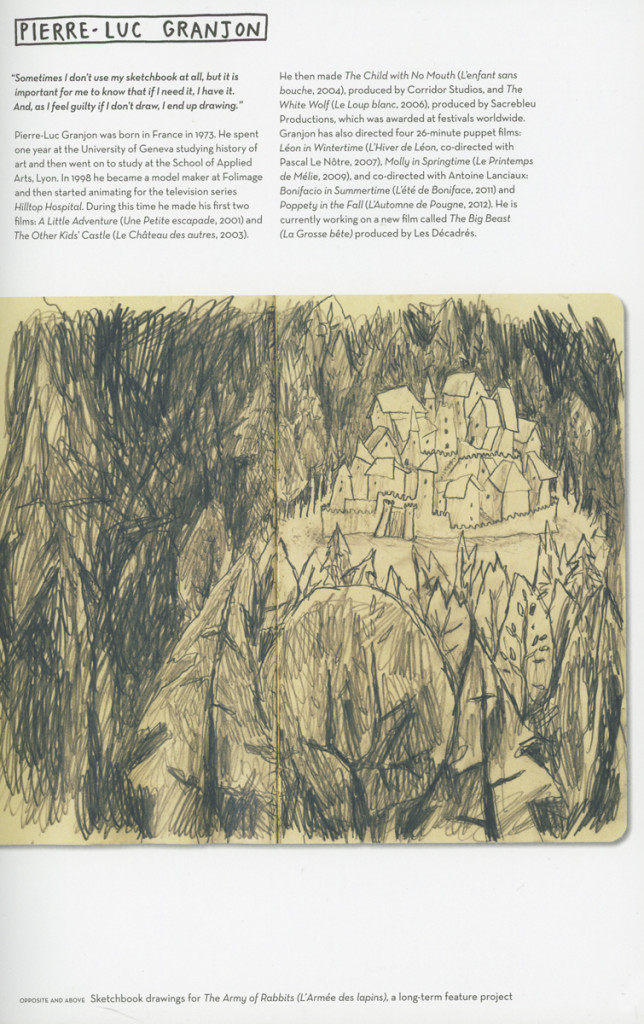
Pierre-Luv Granjon sketchbook dwng 2
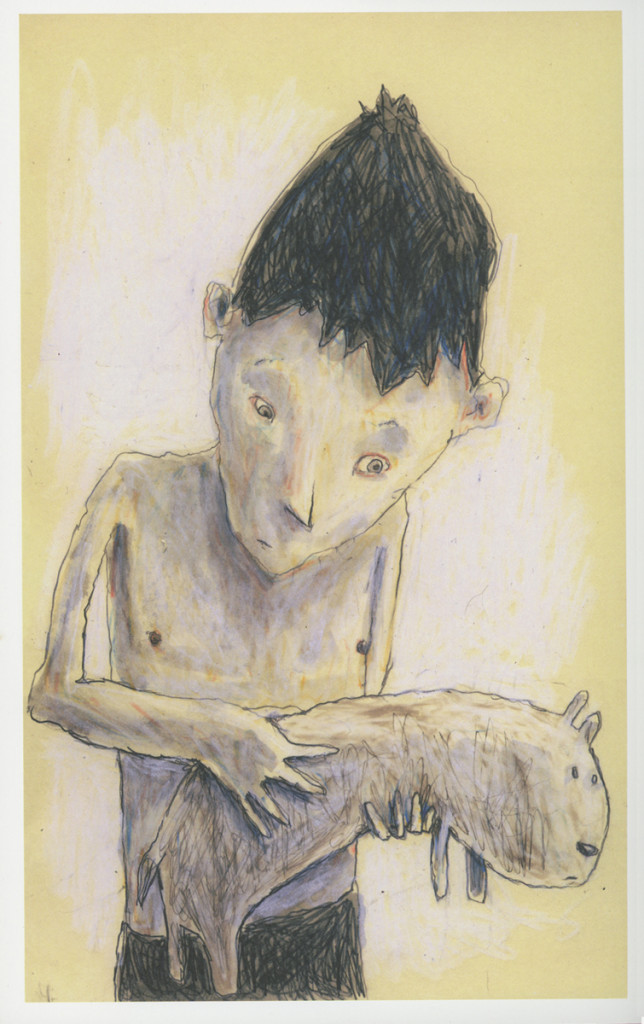
Pierre-Luv Granjon sketchbook dwng.
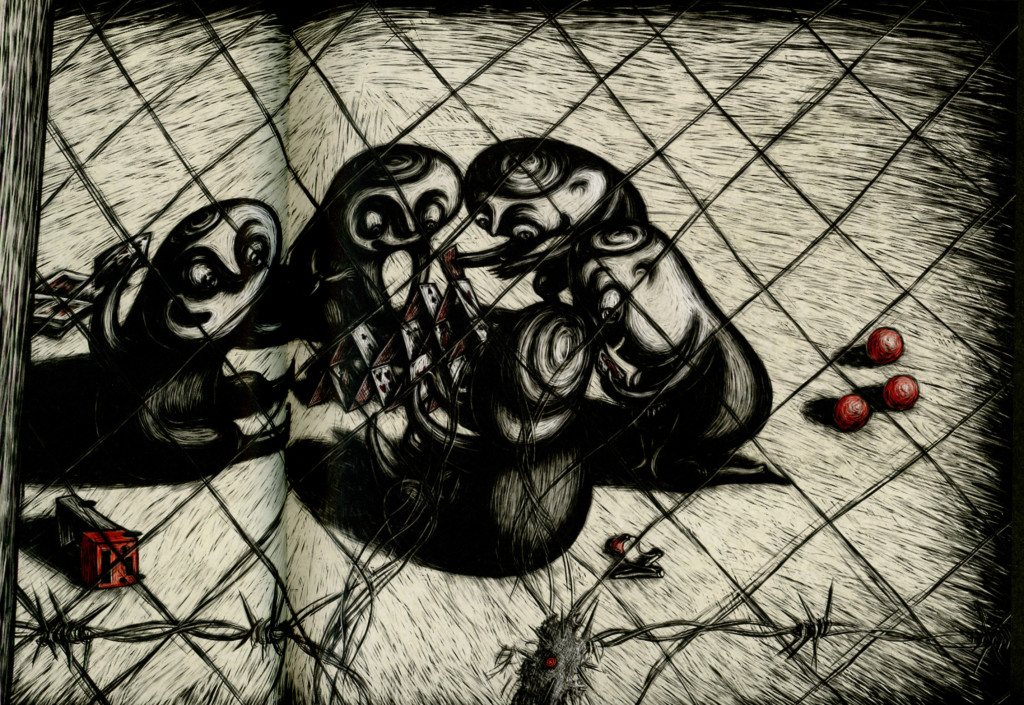
Regina Pessoa Kali the Little Vampire
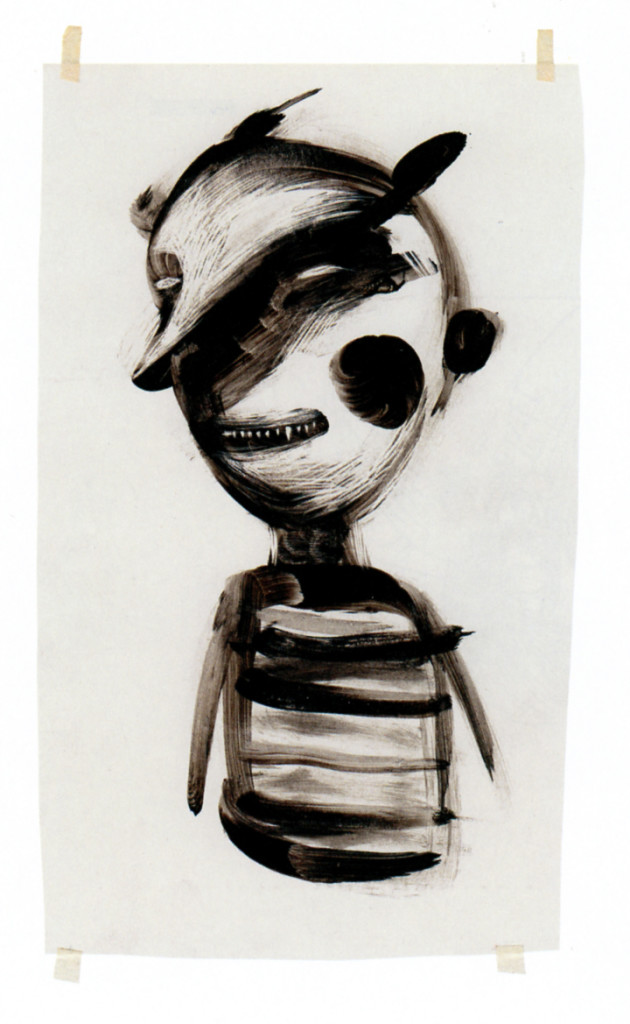
Regina Pessoa sketch Kali, little vampire
Books &Chuck Jones &Commentary &Illustration &Layout & Design &Models 26 Sep 2013 08:22 am
Rhapsody in Working for Suherland
Maurice Nobel worked several years at Warner Bros. under Chuck Jones for the most part, but in 1950 he moved to John Sutherland Productions where he worked on lesser known projects. He had a money war with Eddie Seltzer at WB and accepted the higher price from Sutherland with Selzer telling him that the door would remain open.
WB tried to turn everything to 3D and gave up after one cartoon, Lumberjack Bunny. It’s obvious that some of Maurice’s LOs were prepared for 3D and were switched at the last minute. WB was closed for a year when it was decided to stop production on the 3D films. Noble had taken the right course in working for Sutherland for the few years he was there.
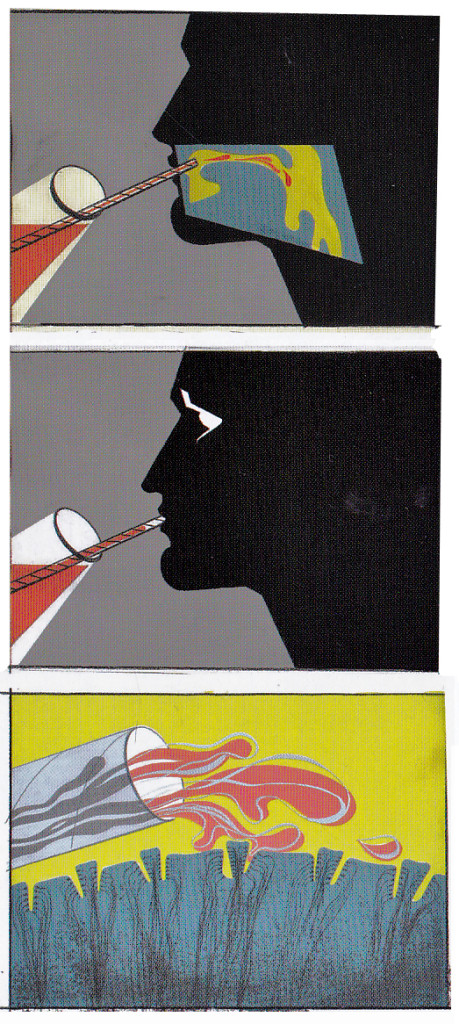
Color keys to the John Sutherland Prod
Gateways to the Mind
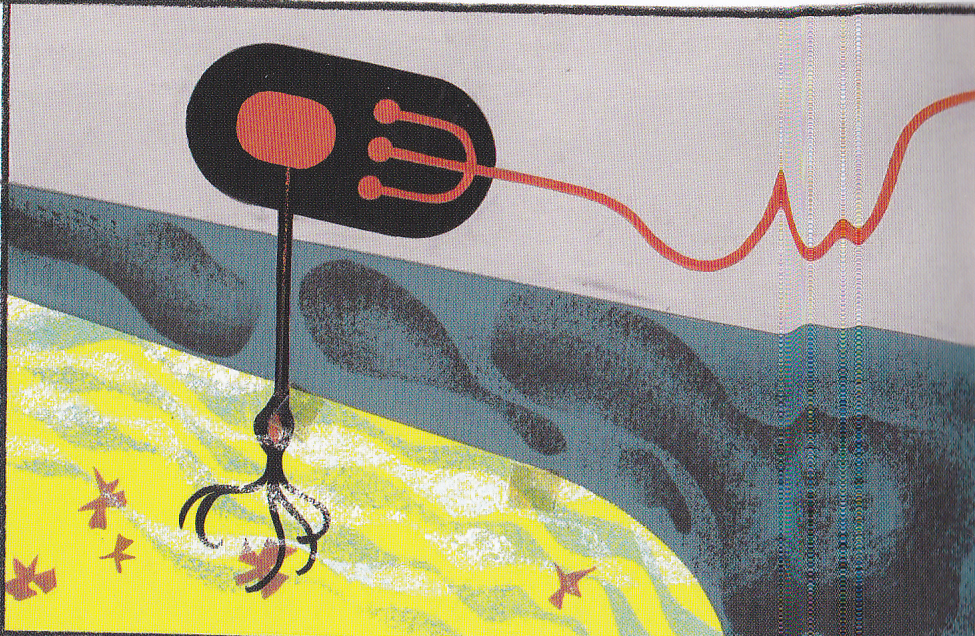
Rhapsody in Steel (below) was a high budget film for Sutherland with Eyvind Earle hired as Art Director. Ultimately he just painted the BGs that were designed by Maurice Noble. This beautiful film can be seen on YouTube, here.
Books &Commentary &Independent Animation 24 Sep 2013 08:14 am
I love the early Warner cartoons. I’m particularly fond of the late thirties and early forties when they were finding their design style, and. in fact, were probably being the most daring in the US with their graphic choices. John McGrew along with the husband and wife team of Gene Fleury and Bernyce Polifka were doing magnificent and, even, daring work. When Maurice Noble entered the scene his was the final wrench to tighten the bolts.
It’s for this reason that I am spending so much time on the opening section of Tod Polson‘s book, The Noble Approach from Chronicle books. Here are some magnificent images from that section of the book. You should go to YouTube and look at A Few Quick Facts About Fear. It’s a magnificent work that was done for the Signal Corps (although it was done by UPA in its very earliest days.)
Desert Designs by Noble
John McGrew’s BG designs for The Unbearable Bear
Animation Artifacts &Articles on Animation &Books &Commentary 23 Sep 2013 08:00 am
Heading Toward WB
Maurice Noble began his art career at Chouinard’s Art Institute. He and Mary Robinson (Blair) followed similar paths at the school. They both moved on to jobs decorating windows of Robinson’s Department Store. Their design styles were in no way similar, but their approaches to the art were. This was during the Great Depression, and there was no chance of getting a raise of salary there to match what ould be earned at Disney, They both moved on to working at Disney’s Studio.
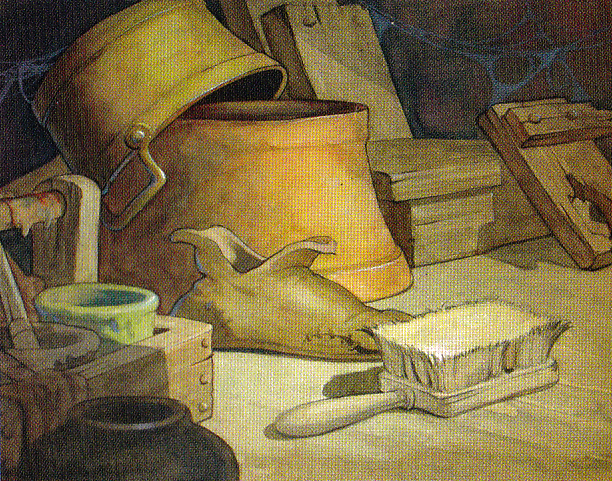 His first assignments were in painting backgrounds for some Silly Symphony cartoons such as Elmer Elephant, Water Babies, The Old Mill and The Country Cousin. All of these were “A” list Symphonies and were certainly plumb assignments within the studio, yet it took Maurice a short bit of time to appreciate the move he’d made toward animation. He soon found himself painting backgrounds on Snow White and designing on Bambi, Pinocchio, Fantasia and Dumbo. On Dumbo he helped to design the Pink Elephants sequence. He developed his personal approach to animation design.
His first assignments were in painting backgrounds for some Silly Symphony cartoons such as Elmer Elephant, Water Babies, The Old Mill and The Country Cousin. All of these were “A” list Symphonies and were certainly plumb assignments within the studio, yet it took Maurice a short bit of time to appreciate the move he’d made toward animation. He soon found himself painting backgrounds on Snow White and designing on Bambi, Pinocchio, Fantasia and Dumbo. On Dumbo he helped to design the Pink Elephants sequence. He developed his personal approach to animation design.
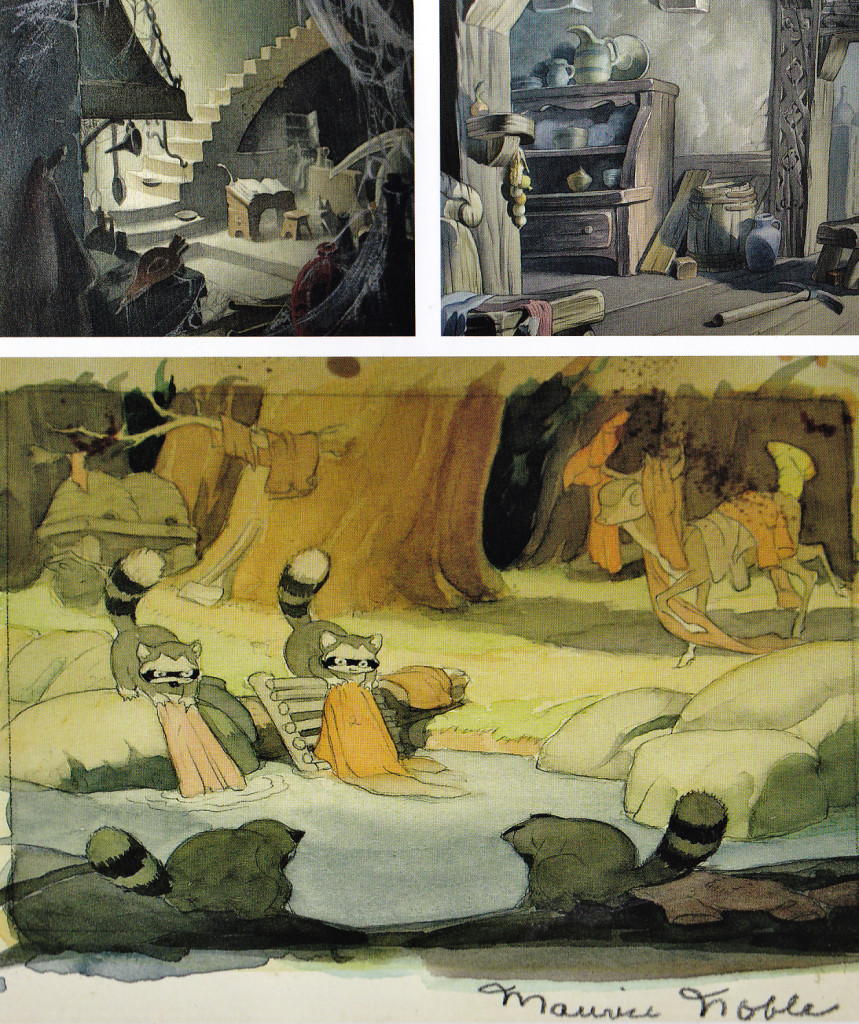
Selected art by Noble from Snow White
There was also a legendary screening, set up by Frank Lloyd Wright, attended by many at the Disney design group, of a Russian animated film called The Tale of Czar Durandai. This 1934 short film was directed by the famous Ivan Vanov-Vano. John Hubley also used thisfilm as an example of inspirational work for the animation he was to do.
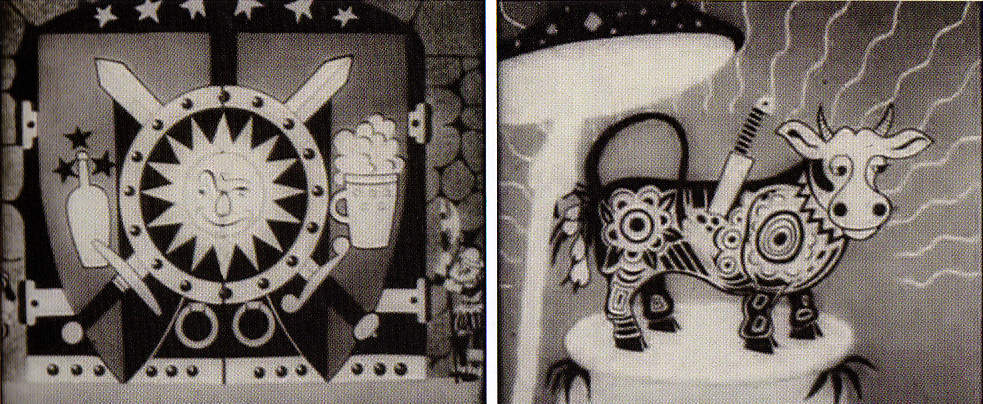
The Tale of Czar Durandel
Maurice Noble had also participated in the strike at Disney’s. When it was over, he was given a second-rate office, and it was obvious he was no longer in high demand at the Studio. He sat doing nothing for quite some time before receiving severance pay. He then joined the Signal Corps to work for the Army. The aggregation of artists who had joined the group was a top-notch selection of excellent designers all of whom were committed to 20th Century Art in animation. Animation had joined the Modernist movement, and was on its way to producing “adult” fare.
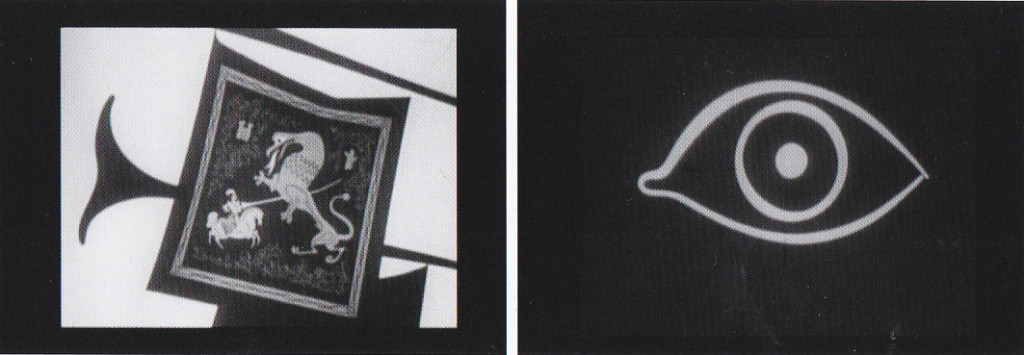
A Few Quick Facts About Fear was a short produced/directed by Zach Schwartz
which took complete use of the new approach to artwork in animation.
Noble worked with Zach Schwartz on a film which led the way to the new approach to animation art. The film was done purposefully in B&W using a bold approach to the art.
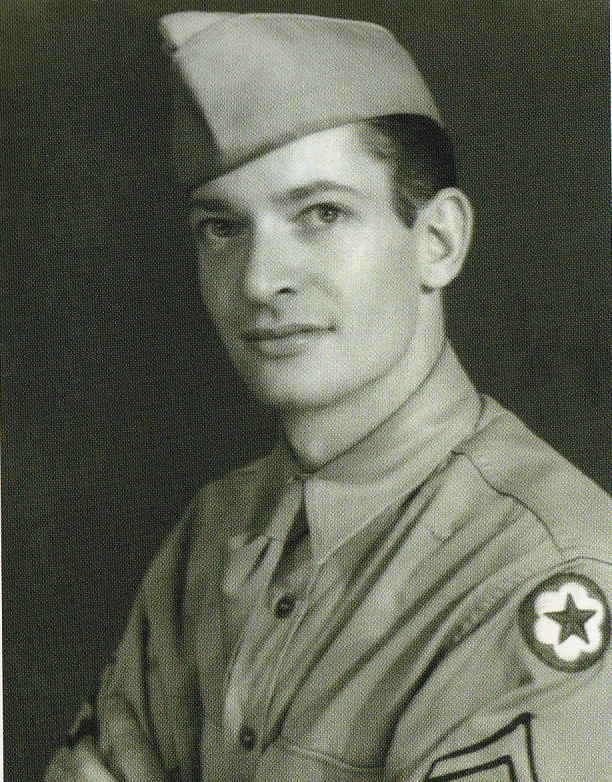
Maurice Noble in the SignalCorps.
Books &Commentary &Illustration 16 Sep 2013 07:45 am
More of Steadman’s Alice
Here are a few more pages of Ralph Steadman‘s Alice In Wonderland. This takes us up to Tweedledee and Tweedledum. Major scanning coming up, so I had to break here.
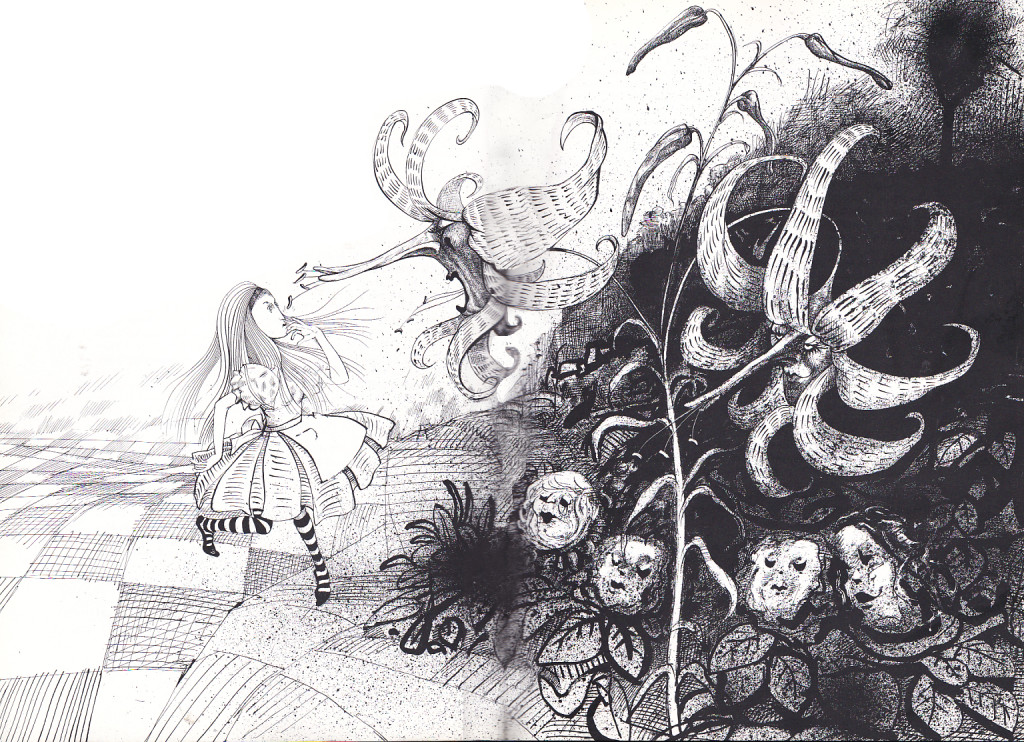 1
1
Articles on Animation &Books &Chuck Jones &Illustration 27 Aug 2013 11:11 pm
More Than the Scenery
I am a fan of the work of John Ford. If I’m caught catching a minute of one of his films, you’ll see me stay through to the end. Likewise I have almost as great a respect for the animation design work of Maurice Noble.
It never fails. I get to the point where I’ve just about run out of hope for animation, and I feel like the greatest pessimist in the world. When I say “animation,” I mean 2D. Every frame is controlled by one person. The rest – cgi – is, to me a graphic effect, electronic puppetry. I’m certainly not talking about the overacted cg action you see in most films done today. Most animation to me, these days, is something that’s done in a computer by teams of people, and isn’t wholly designed as “personal.” There are, of course, the exceptions. When something like THE LIFE OF PI shows up, it feels like magic; the magic you expect of great animation.
There’s just too much of everything in most current animation; even the flash Mickey Mouse spots go too fast with their Zips, Pans, Takes; the simplest move seems to go over the edge. Gestures are bigger than they need be, actions are over the top, dialogue is too loud and frenzied unless it wants to be quiet – then, it really is dead. The animator became that big red button they have at “Staples.” You press it and the client can fix what he has to – his way. The poetry has vanished from the art form when this animation begins. Too bad there’s no personality in those big red buttons.
John Ford made some of the most beautiful movies we have on film. Many of these are Westerns, Westerns which notably featured some of the most extraordinary, natural land masses photographed. The incredible buttes and sights appear in the Arizona Desert, called “The Painted Desert”, and whether they were shot in the glorious golds, violets and other colors or even shot in B&W they add extraordinary sights to these films. If they weren’t already there, constructed and painted by some god, Ford would have had to have a mass of people construct these images.
Working to a better advantage is the art director Maurice Noble who created his original version of the “Painted Desert” mostly out of his own imagination. I suspect he and a couple of other artists were all it took to develop these animated scenics: far fewer people and a lot less time.
As I said, Noble’s desert was original, a recreation of the actual “Painted Dessert” but one that developed out of Noble’s imagination. These are almost as beautiful as the real thing, in that “design-y” way Noble’s art had.
So here we have two film plans. Elaborate impersonal scenery that was designed by Mother Nature, vs the personal designs delicately designed by Maurice Noble. Both are very different but have similar effects on the films they inhabited. A personal world Ford shares with us and another that Noble constructs for the backdrops of the Coyote and Road Runner. Both set designs are larger than life and full of that very-same-life. It’s in gloriously wonderful color (even thoughmany of these sets were shot in B&W) it’s just the beginning of the strength of these films. We’ll look further to see what more has been offerred to us in their films.
